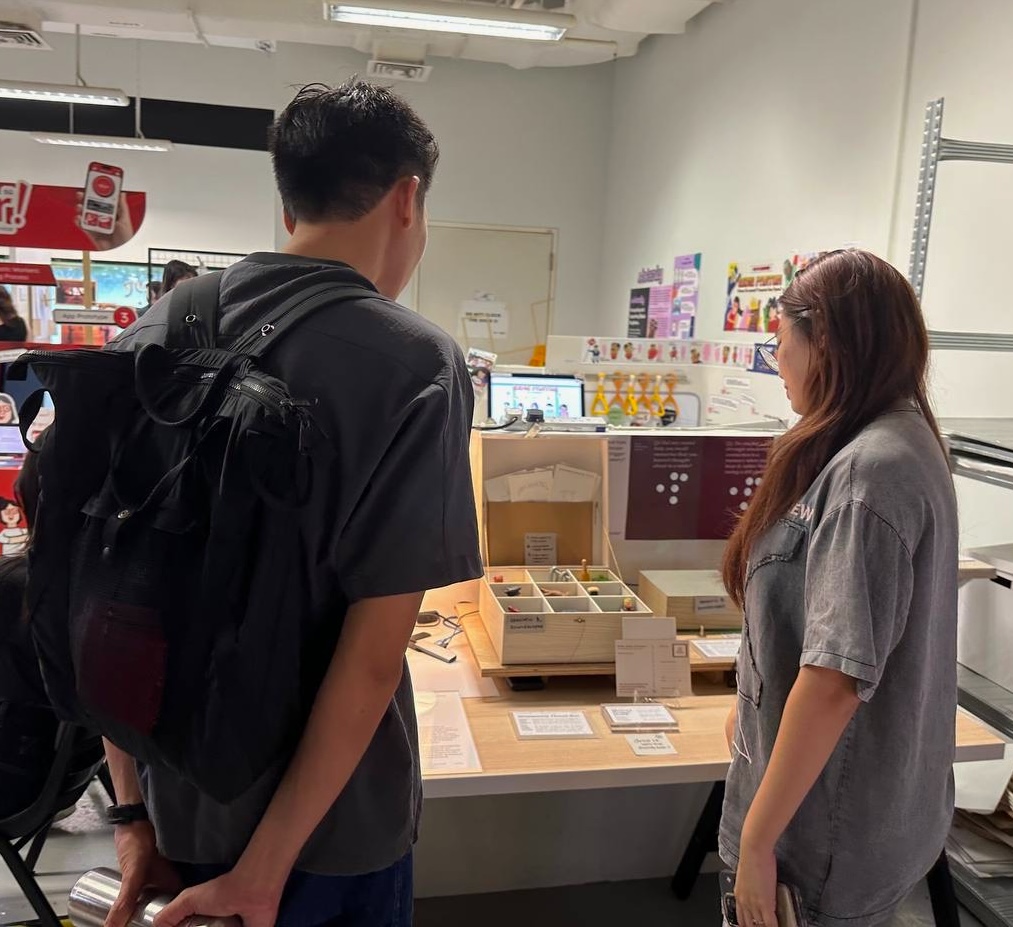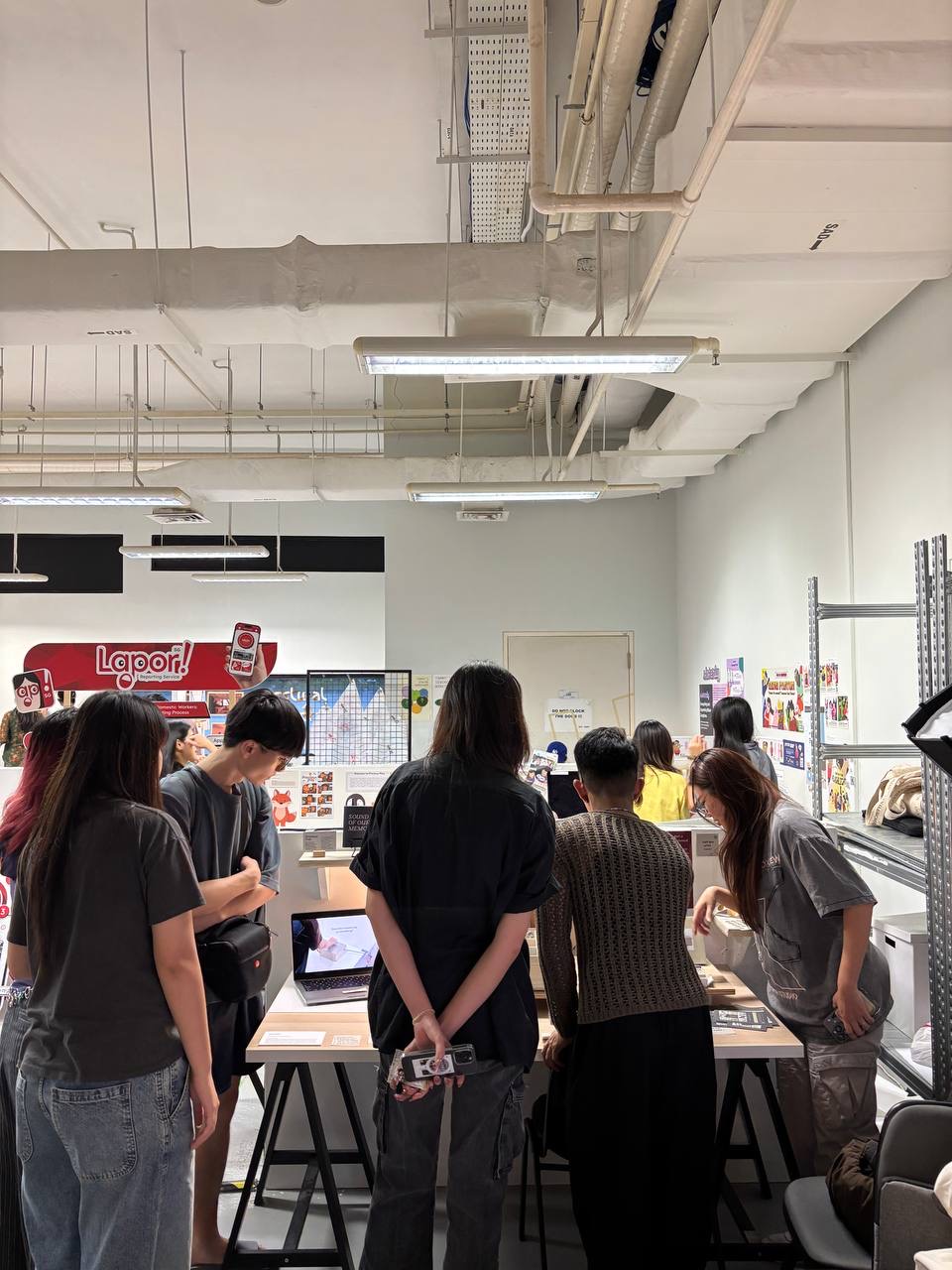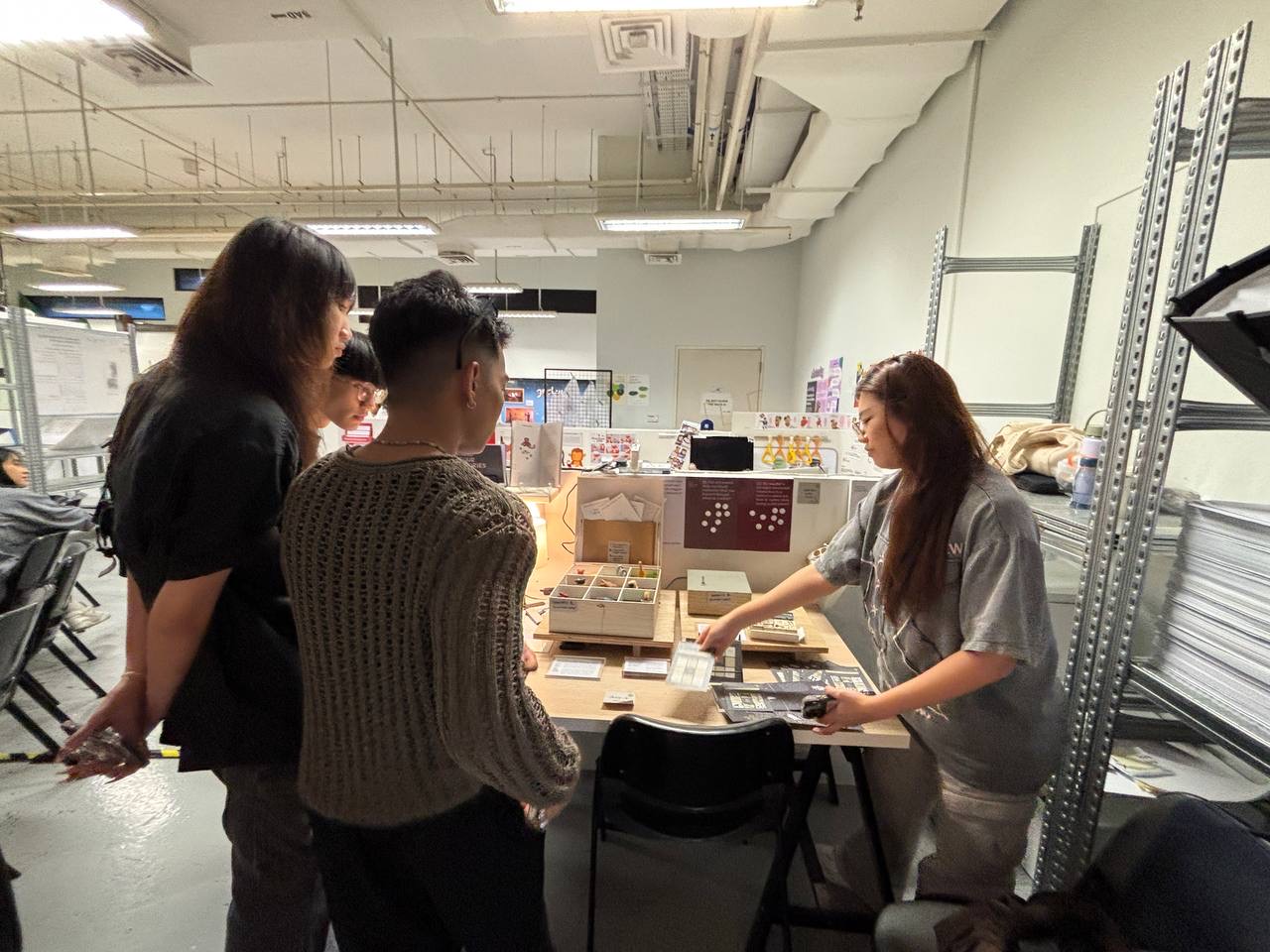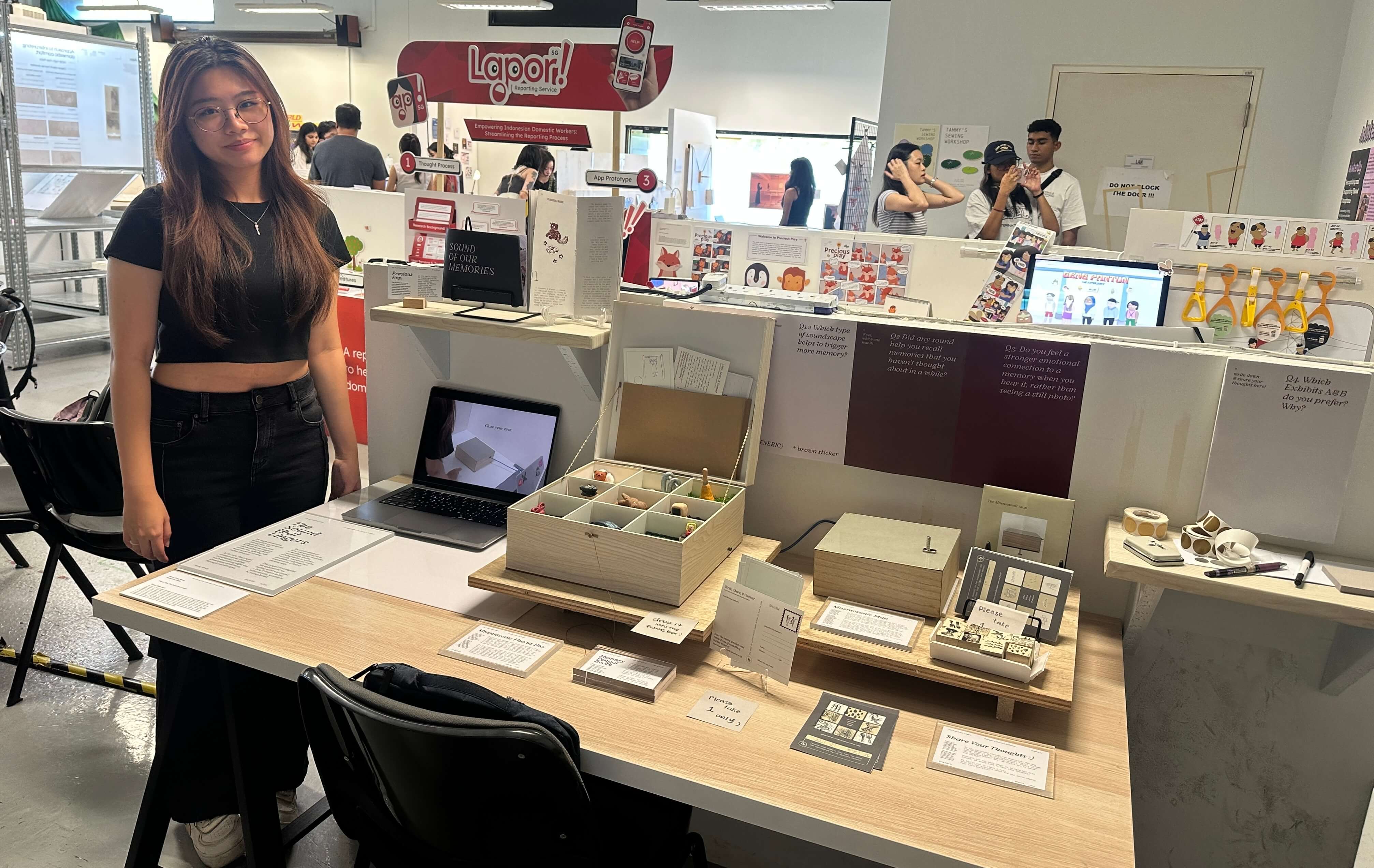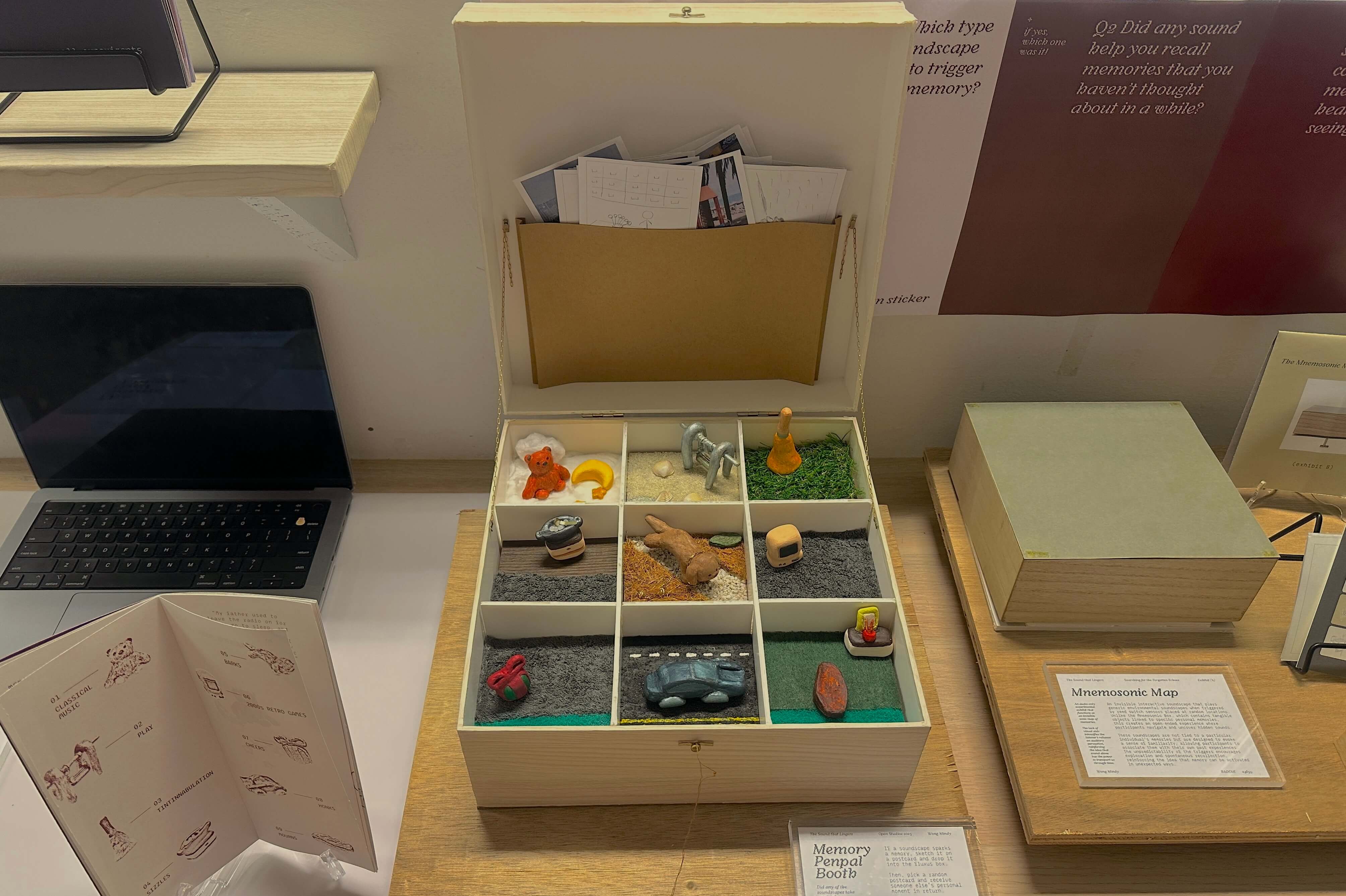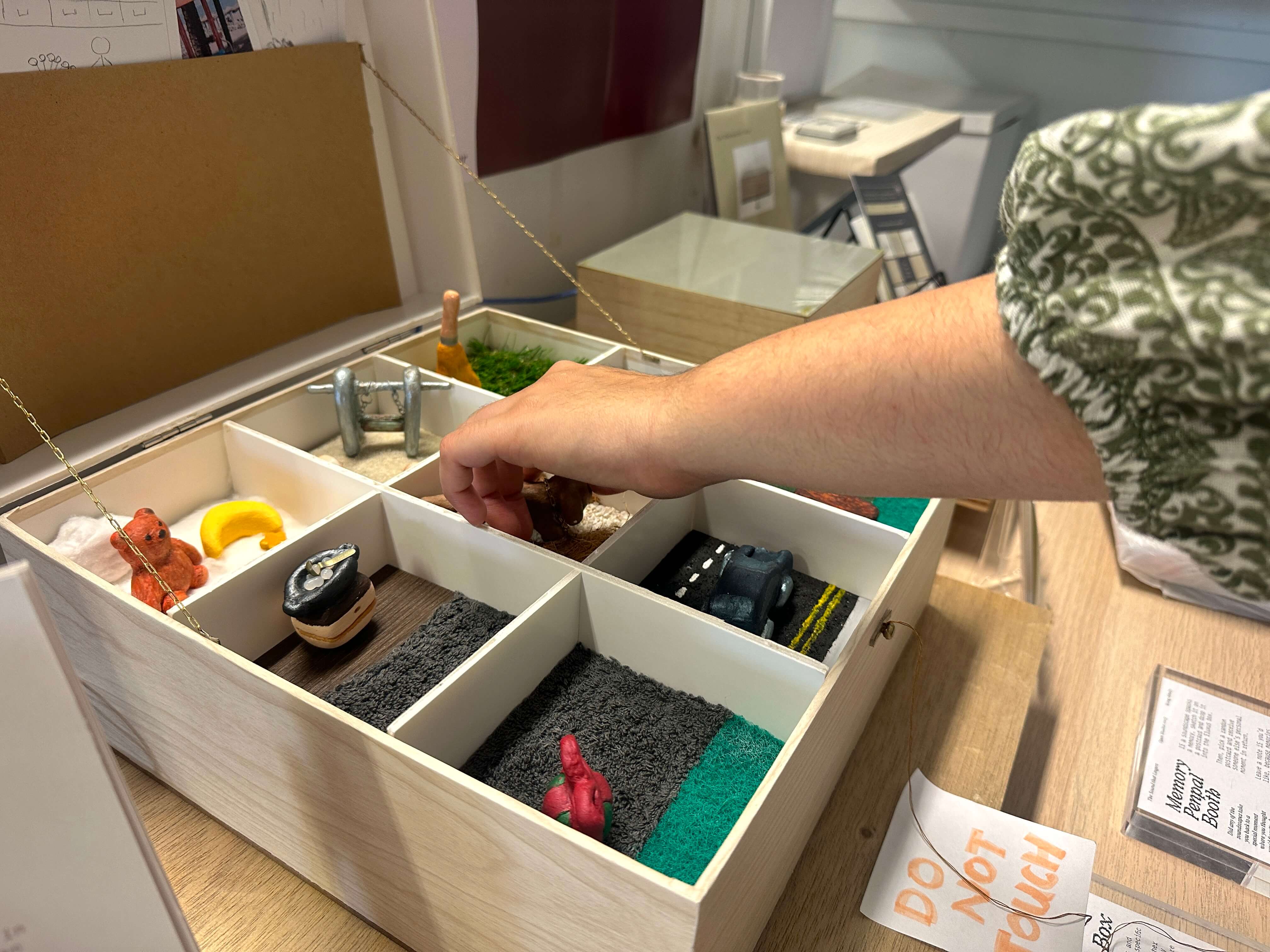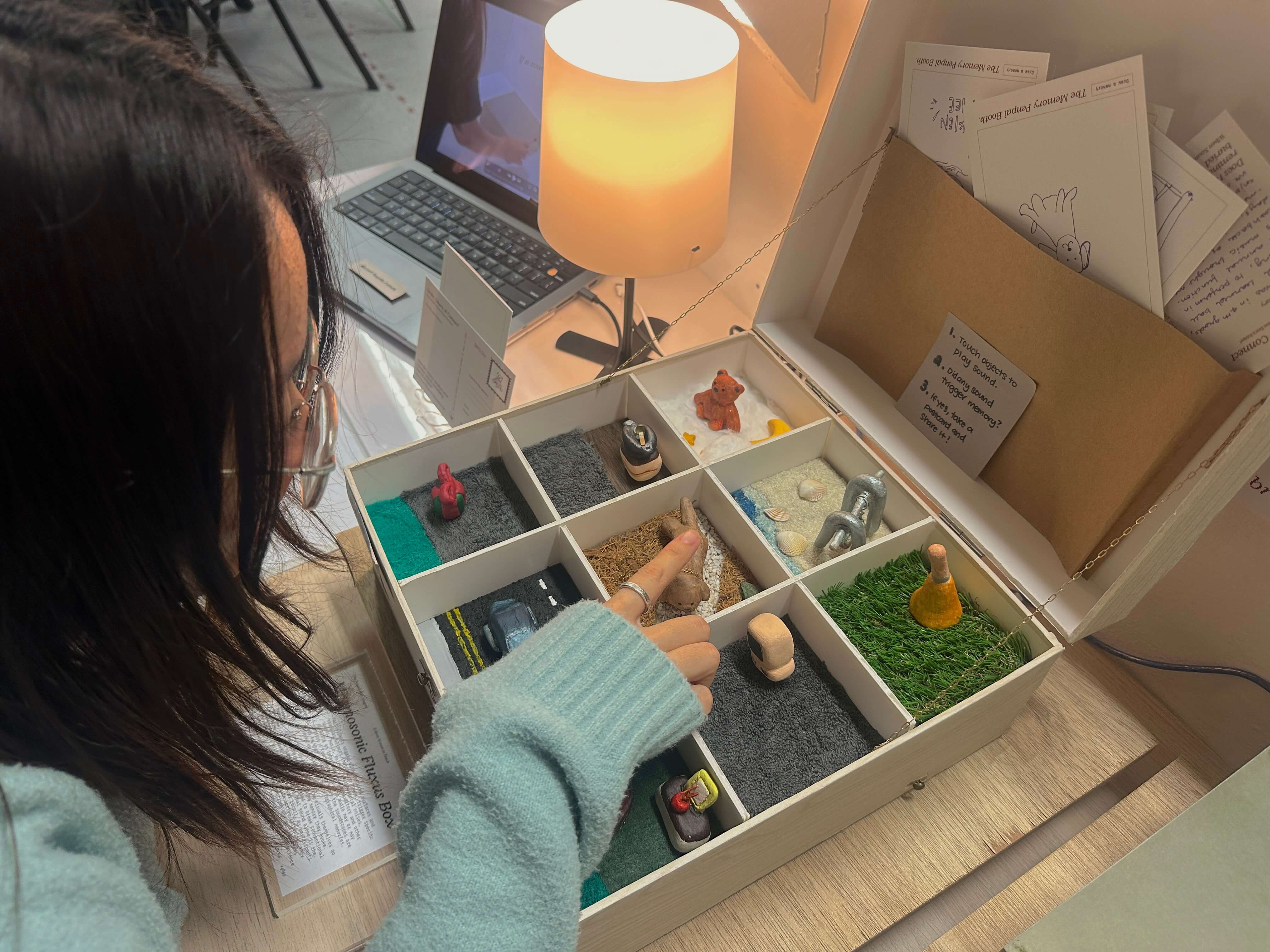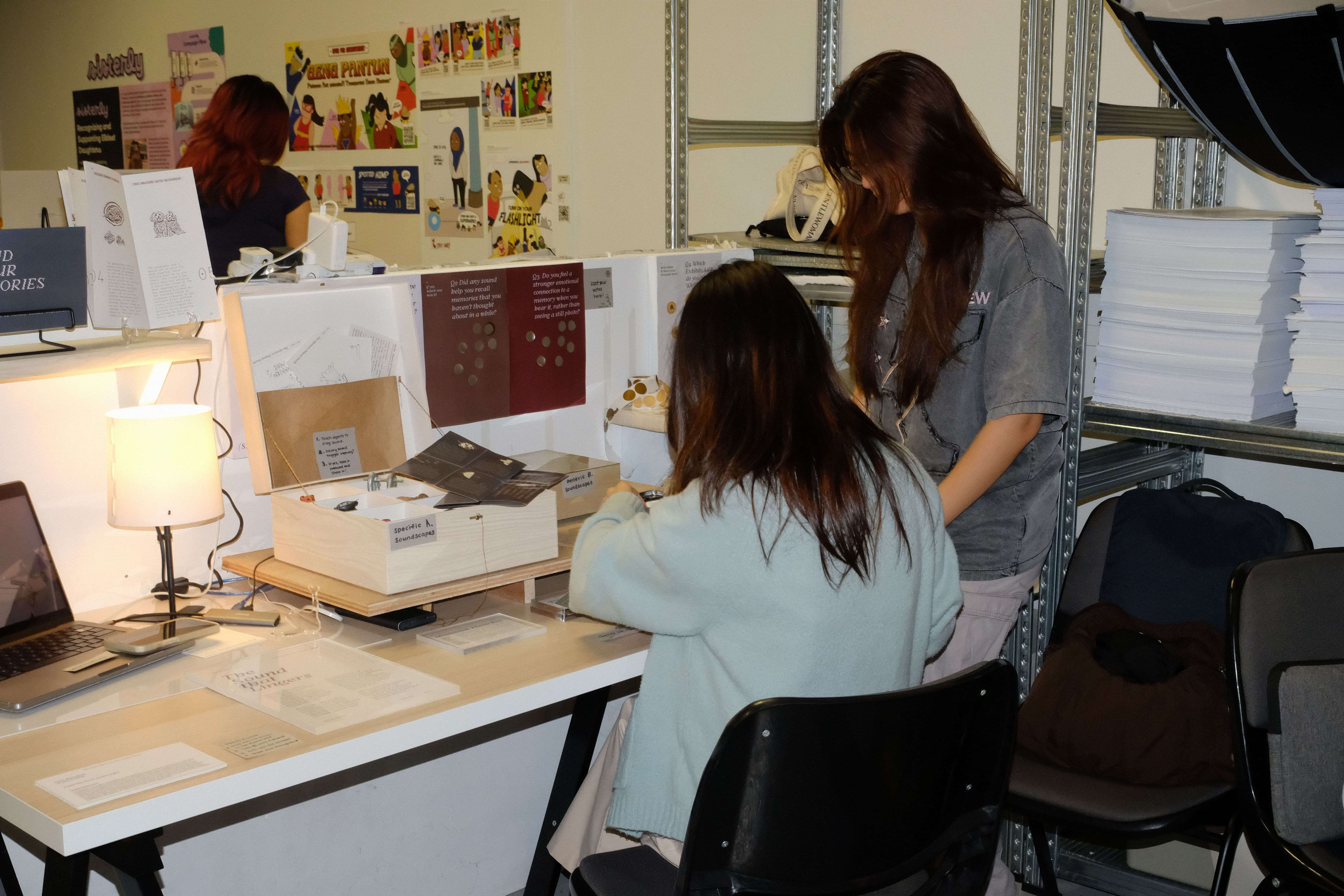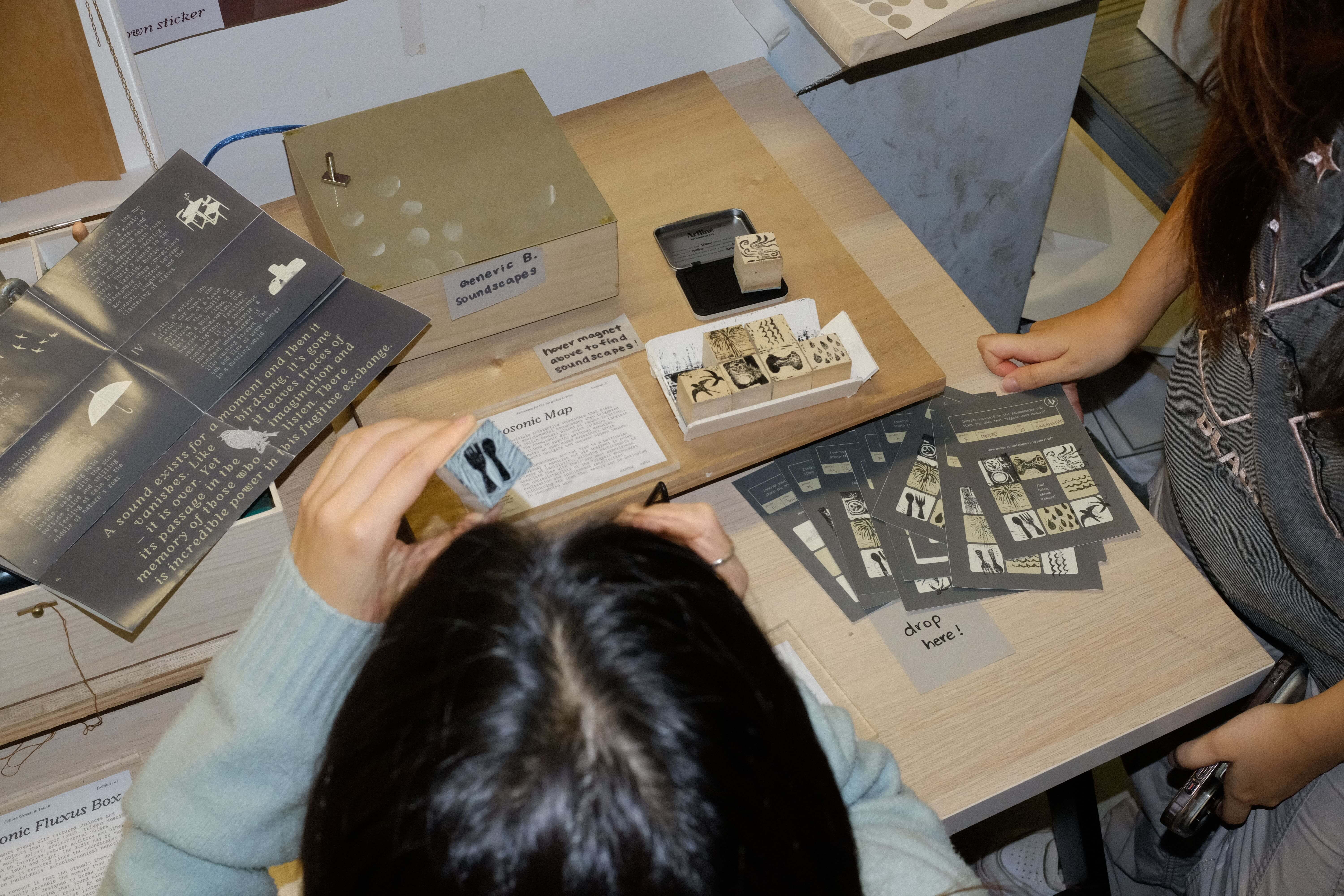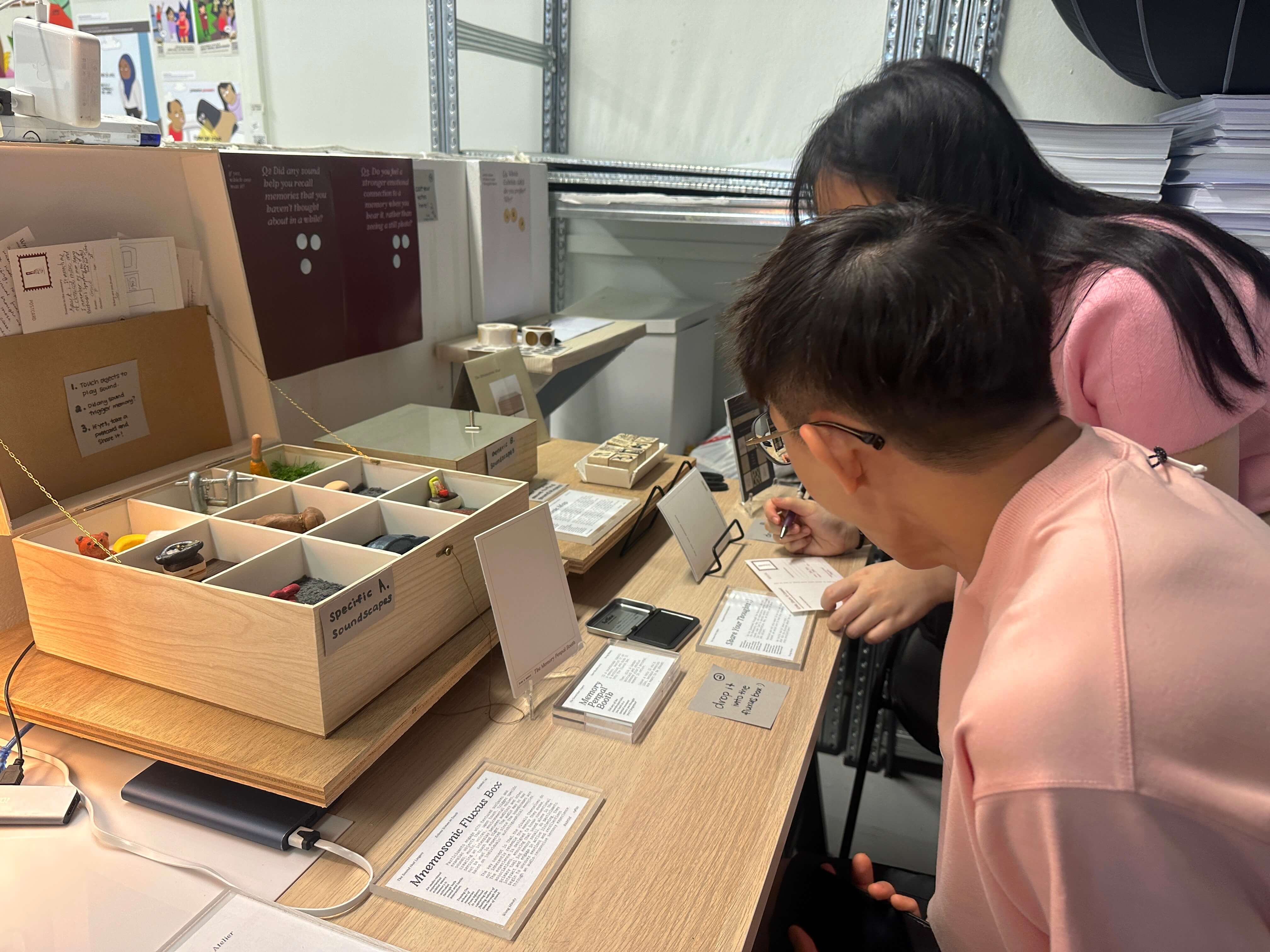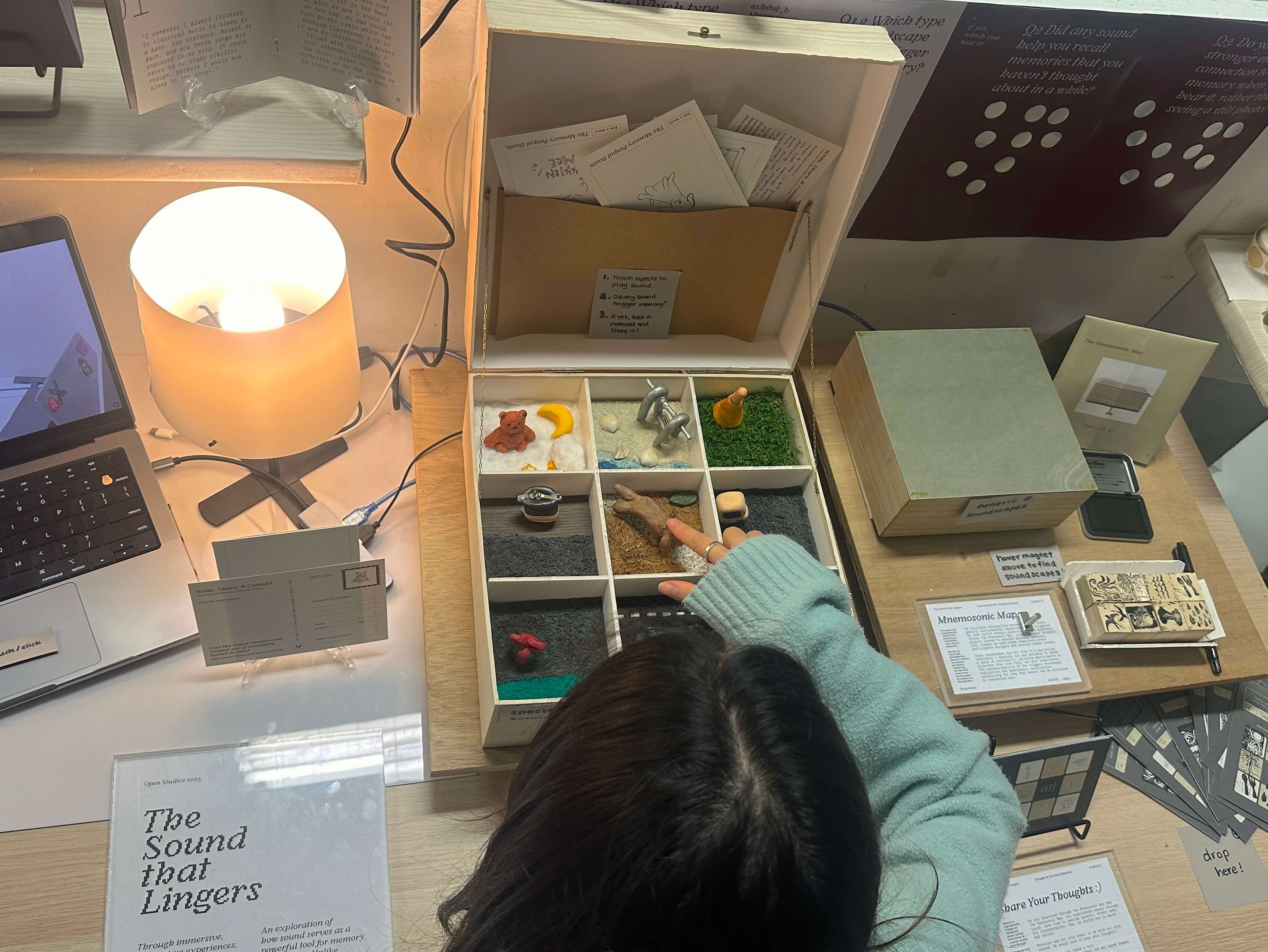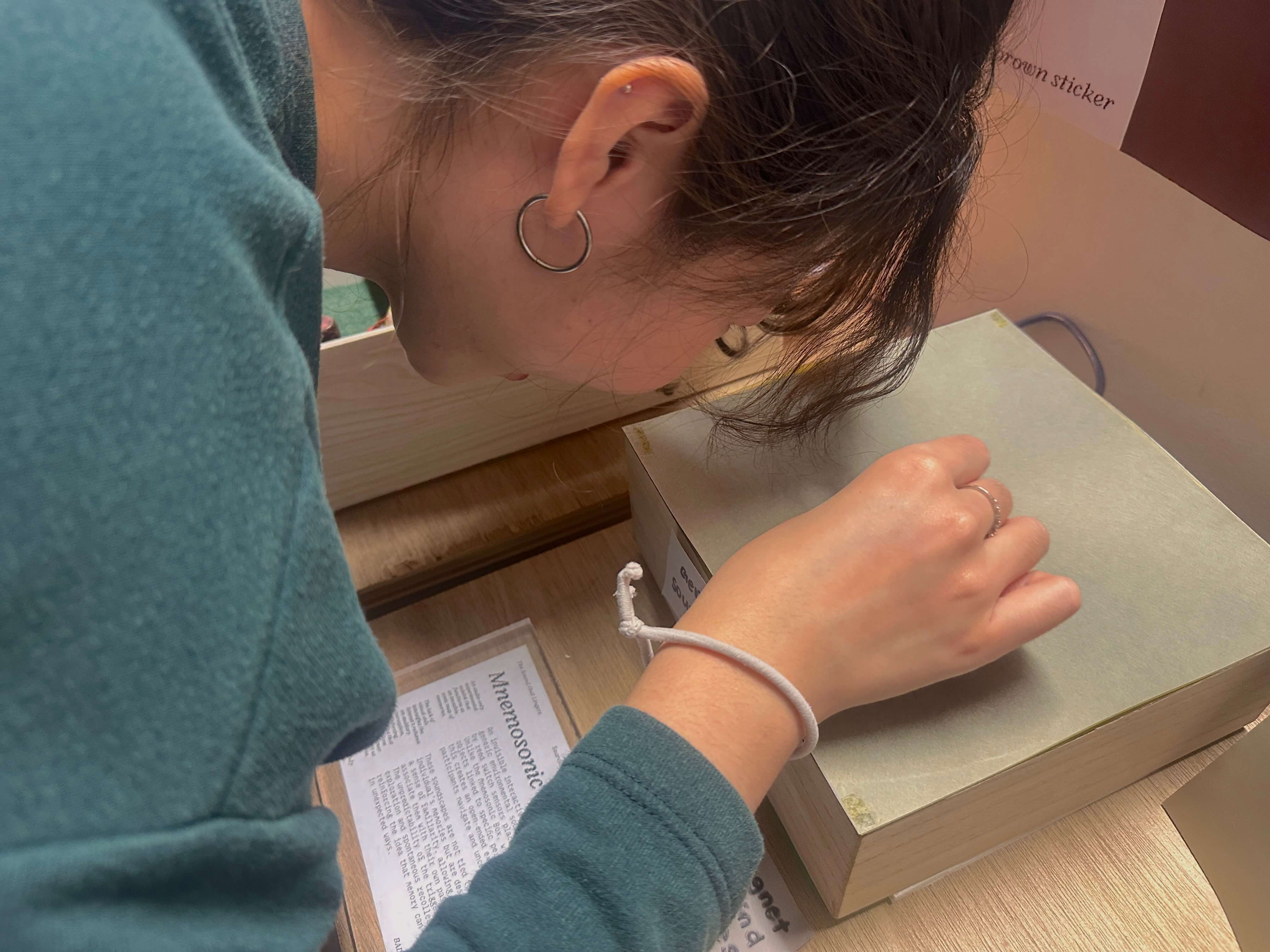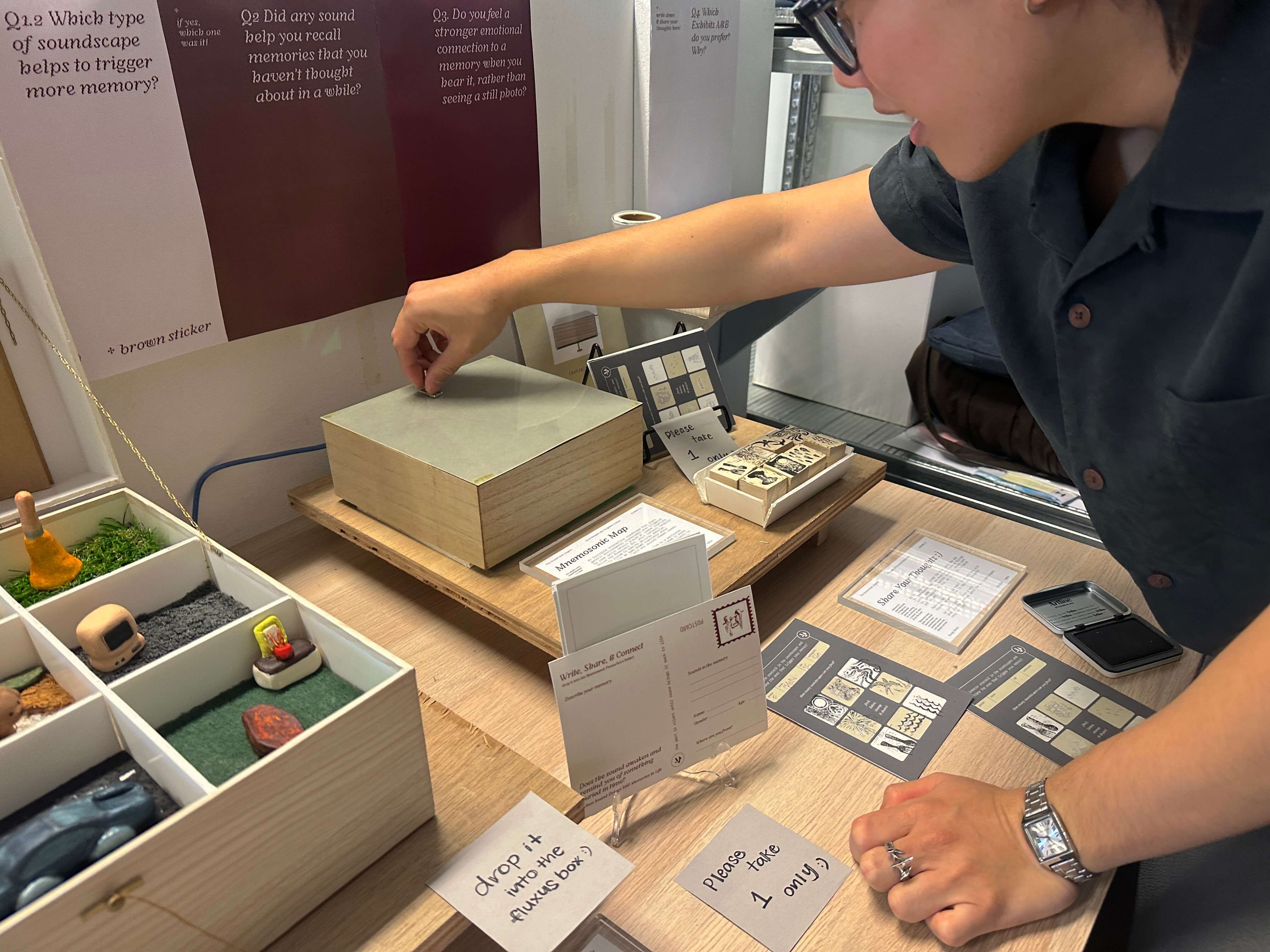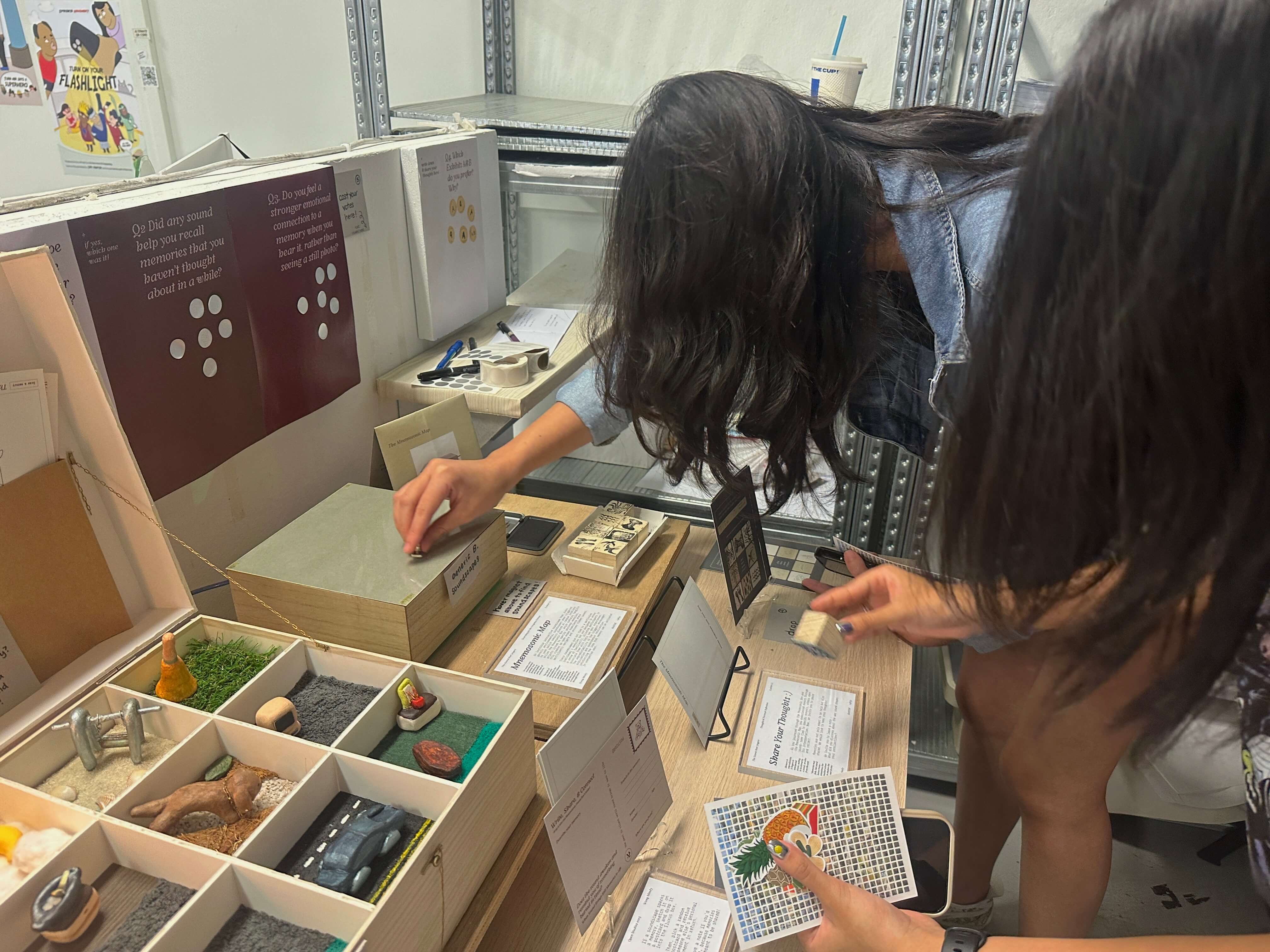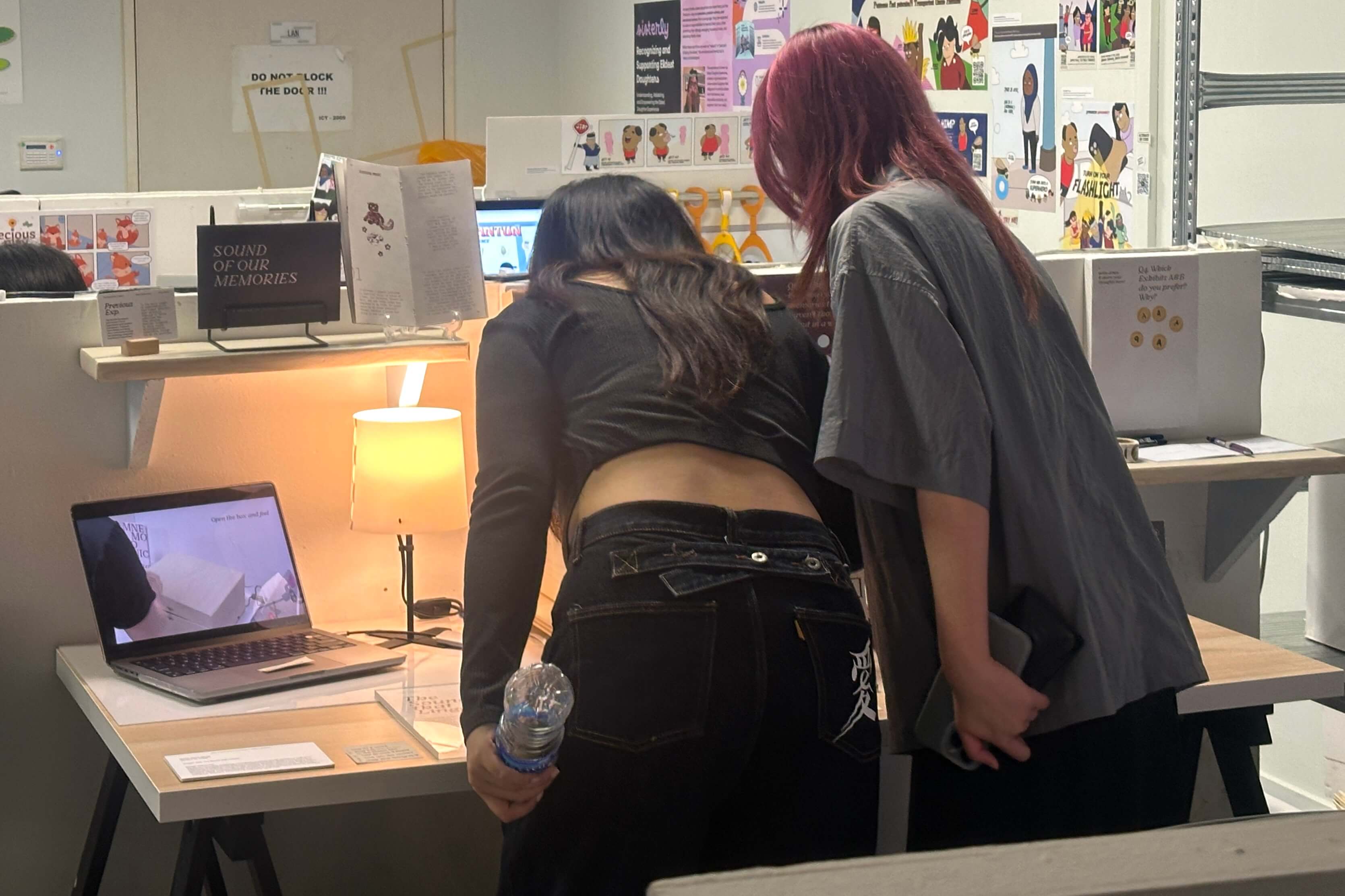ོ࿐˖✶⊹₊𖦹 W.12 OPEN STUDIOS IS HAPPENING! 𖦹₊⊹✶ ࣪˖࿐ོ
FINAL PREPARATION (TUES)
This week's focus is to double check my table set-up, welcoming visitors for Open Studios and document the interactions.
-
Showcasing the [10] Deliverables:
- ✶ Artist Statement
- ✶ Previous Experiments (compiled into a booklet)
- ✶ Mnemosonic Box Booklet
- ✶ Ex.A - 'Mnemosonic Box' (9 audio-visuals)
- ✶ Postcards
- ✶ Ex.B - 'Mnemosonic Map' (8 sounds) & 'Device'
- ✶ Mnemosonic Map Zine
- ✶ Stampcards
- ✶ 8 Linocut Stamps
- ✶ Ex.C - 'Thoughts & Reflections'
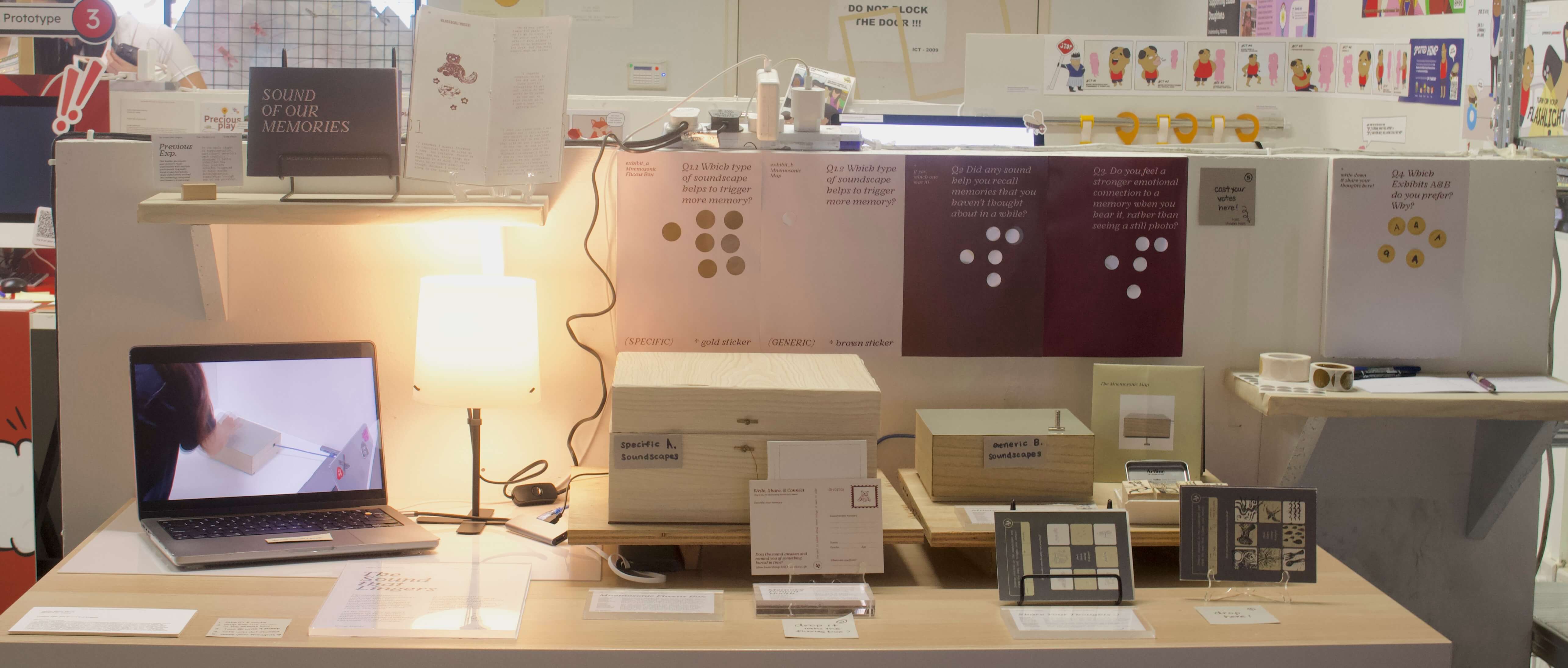
DOCUMENTATION Process
I was happy with my table setup as my envision of it finally came to life. When I first drew the sketch weeks prior to Open Studios, I was worried I was too ambitious as it really seemed like there were too many things going on and at that time I haven't had half of it done out yet. Now, standing right next to my table looking at everything that I've done within a week, I am so glad I was determined and am immensely proud of myself that I had managed to pull it through.
1. Side Elevation Open Studios Setup featuring me :D 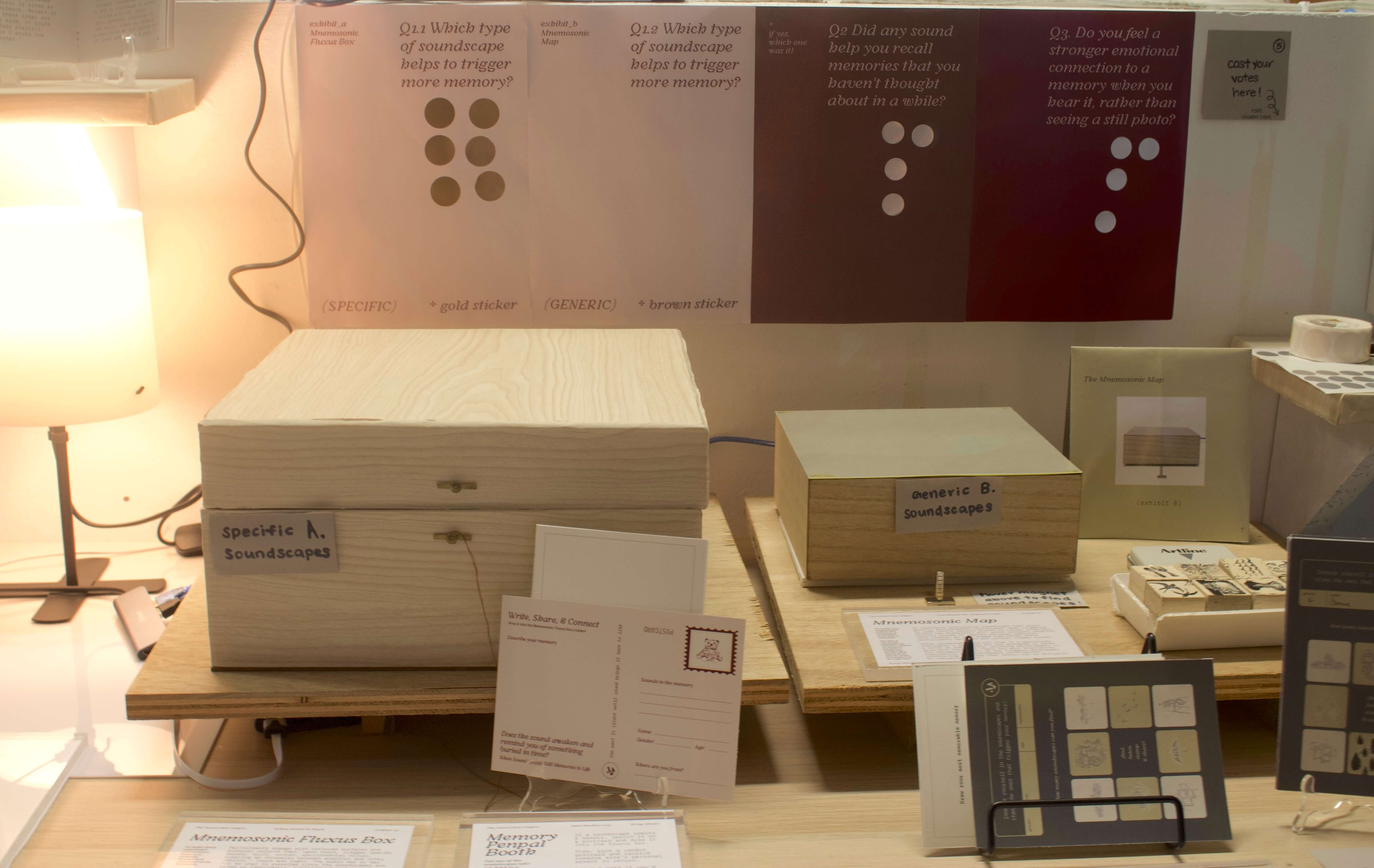
2. Front Elevation of Exhibits A and B 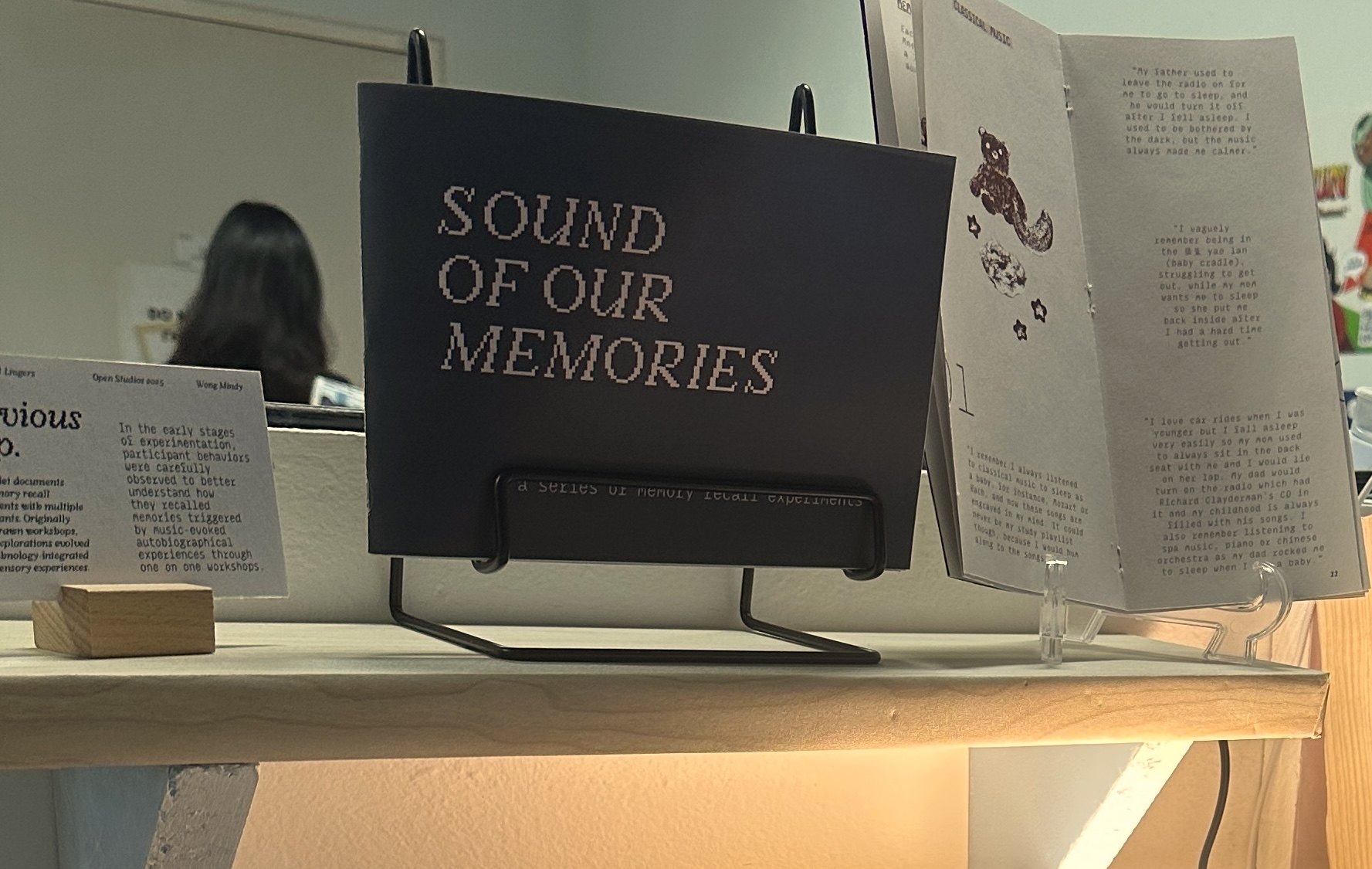
3. DIY Shelvings featuring 'Previous Experiments'
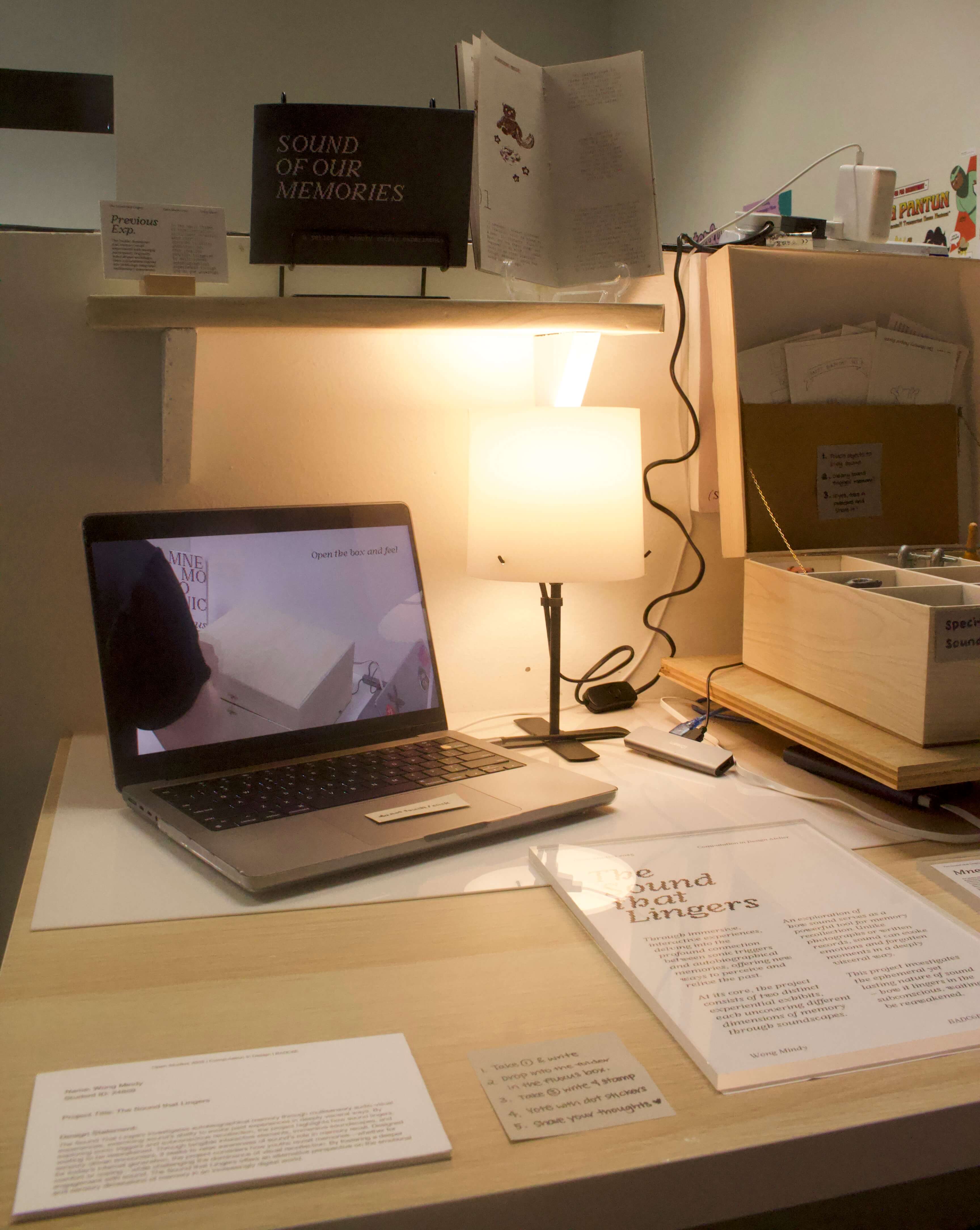
4. A laptop with explainer video playing on loop 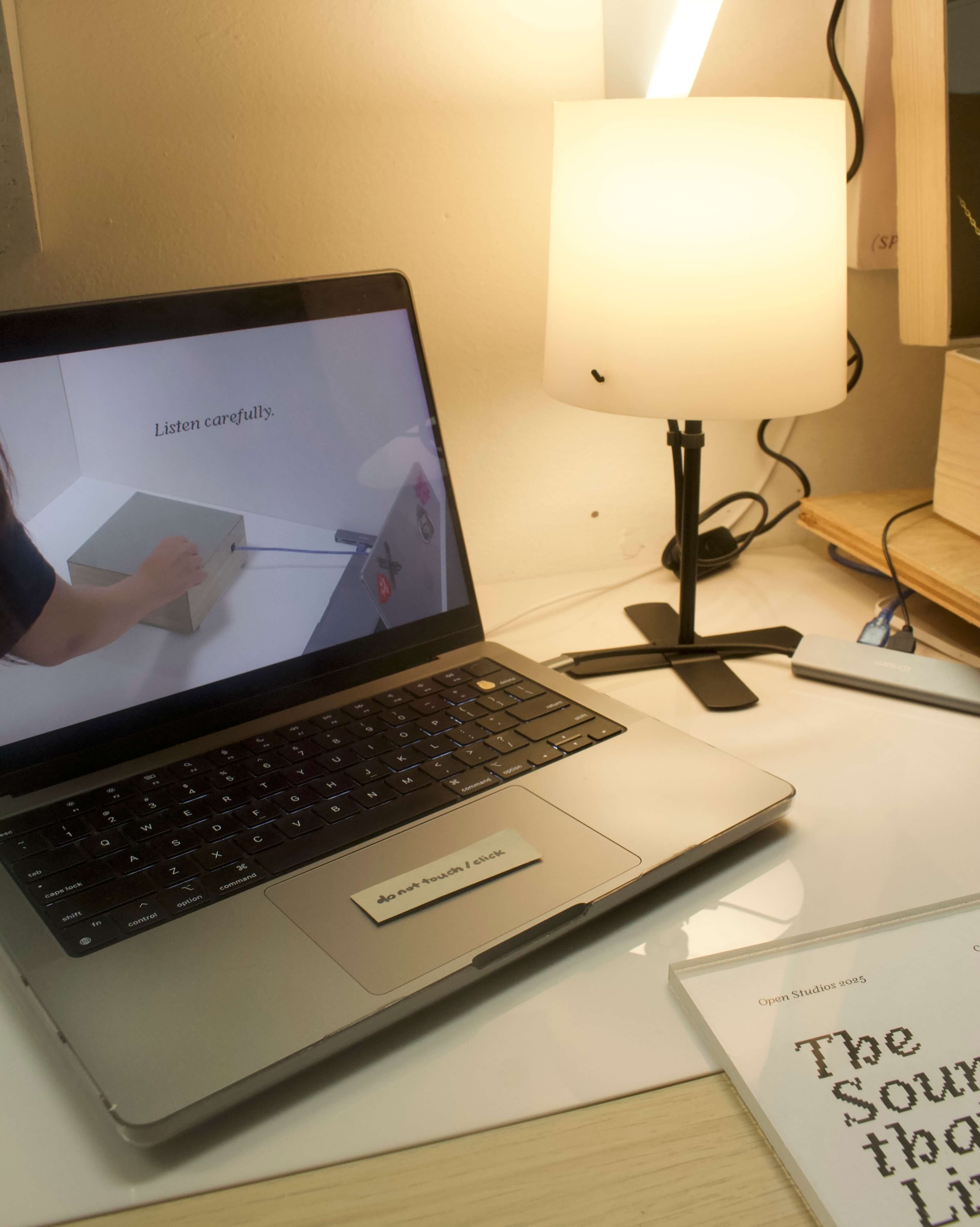
5. Close-Up of video on how to navigate Exhibits A & B 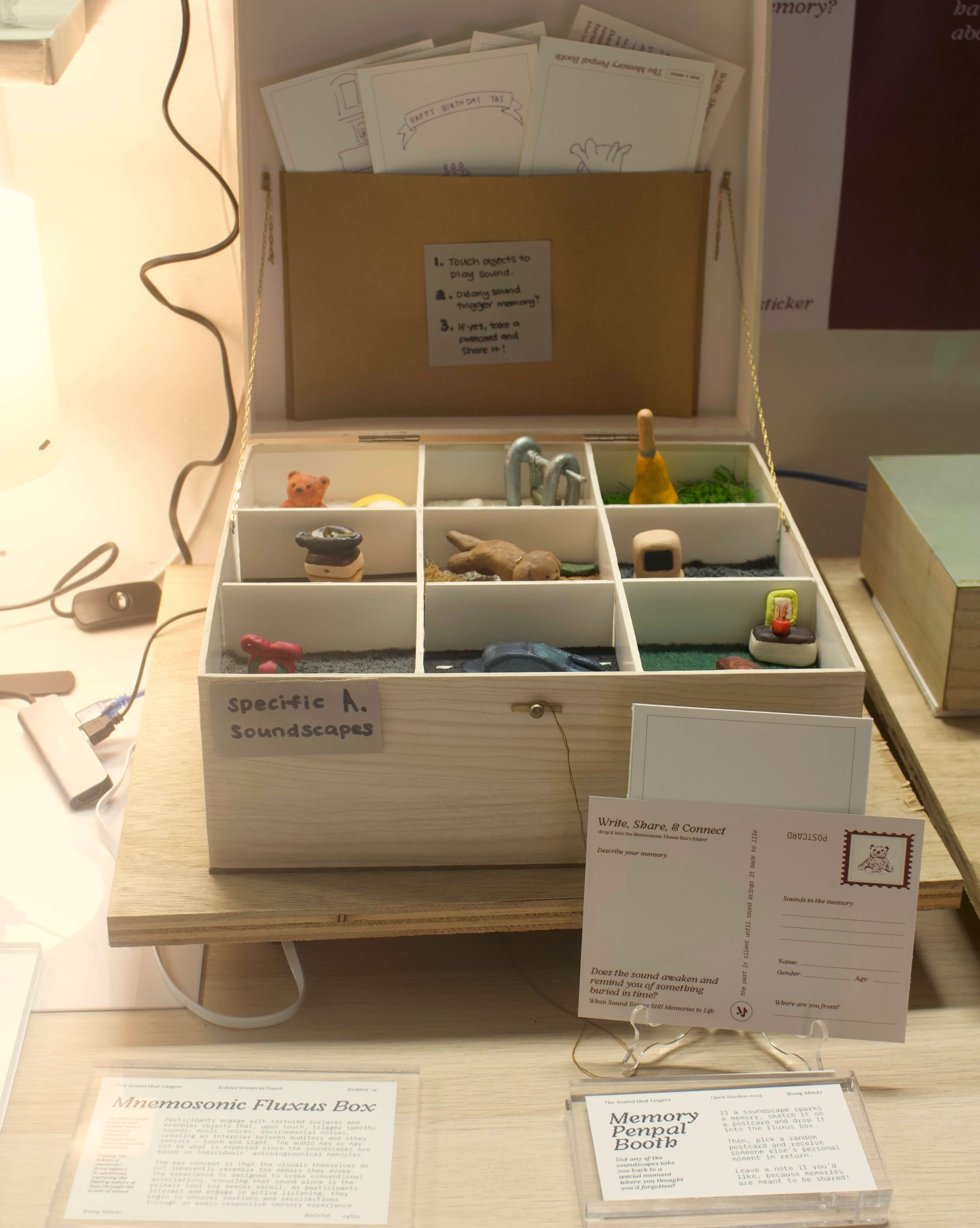
6. Front-View of Mnemosonic Box
7. Top-View of Mnemosonic Box 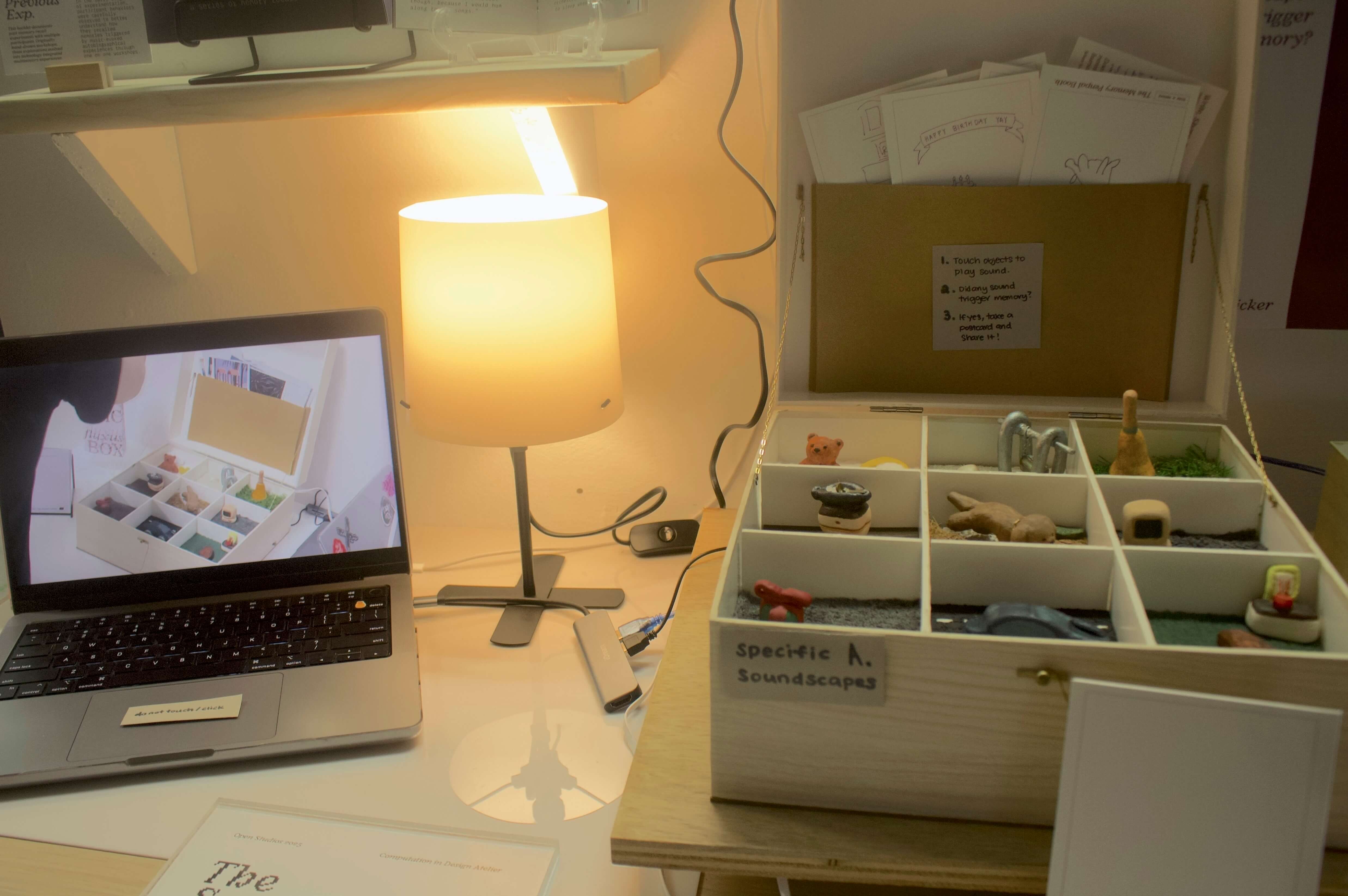
8. How the Explainer Vid works together with Exhibit A 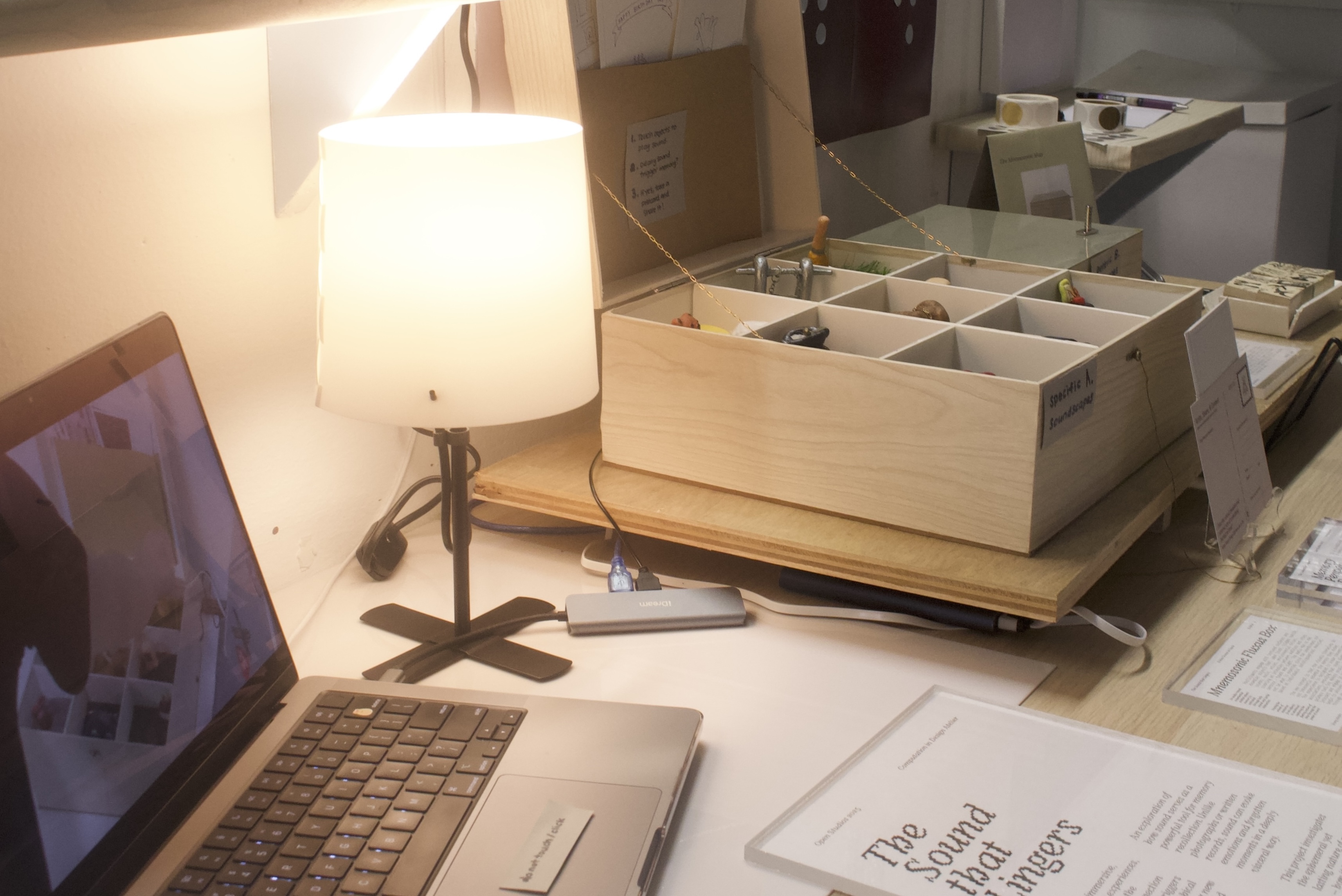
9. Three-Quarter View from start to end
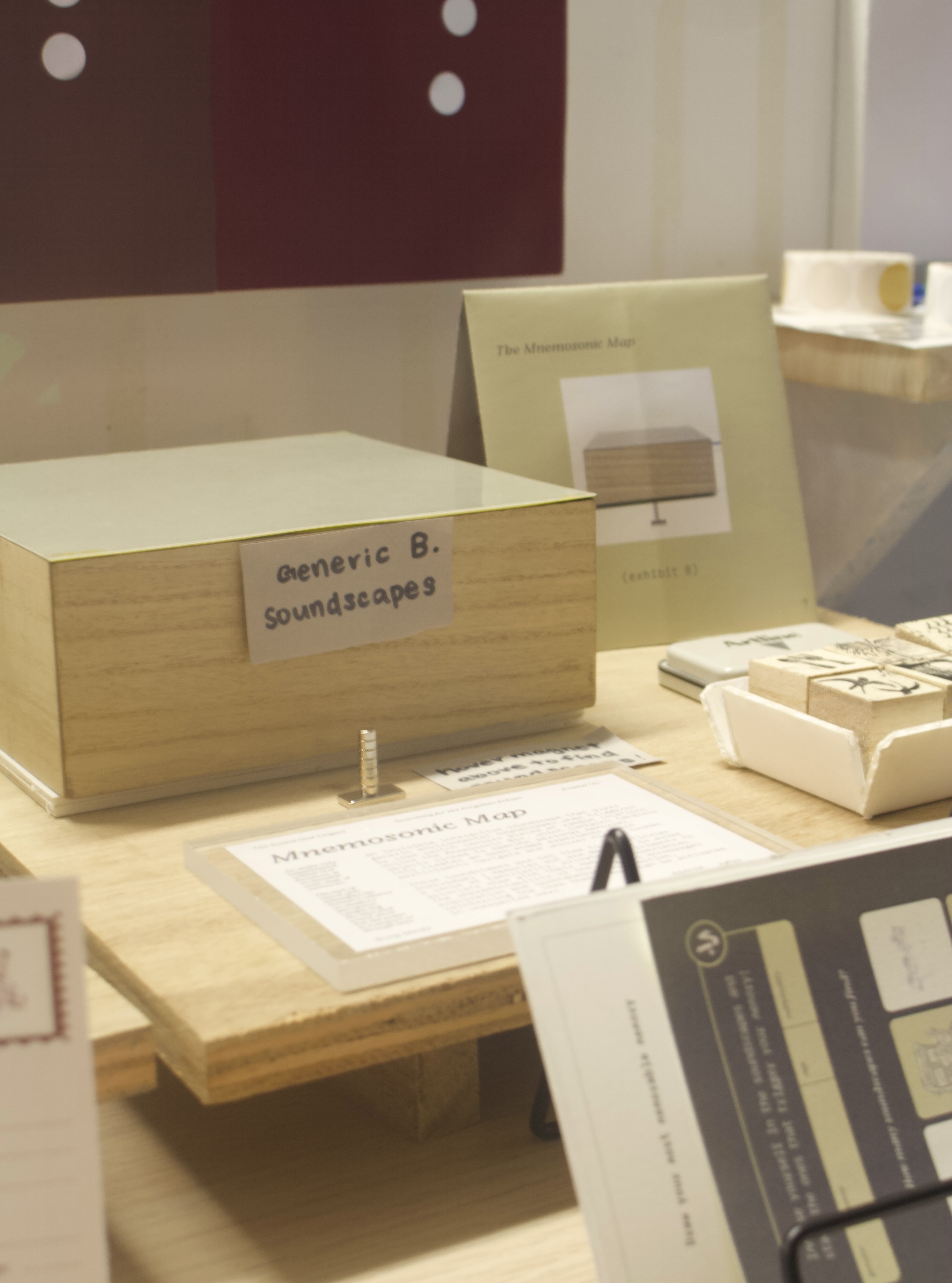
10. Zoomed-In View of Exhibit B 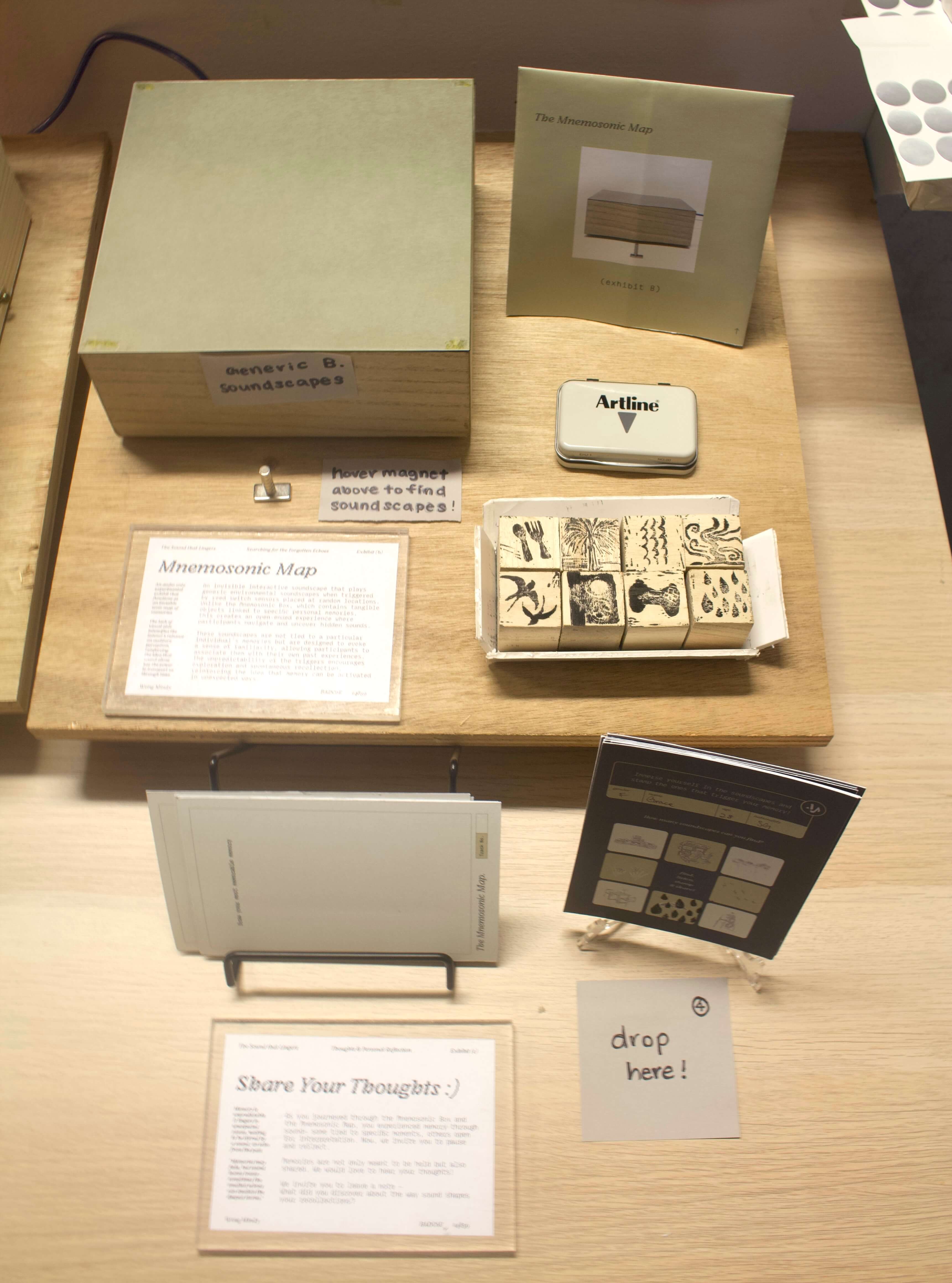
11. Top-View of Exhibit B 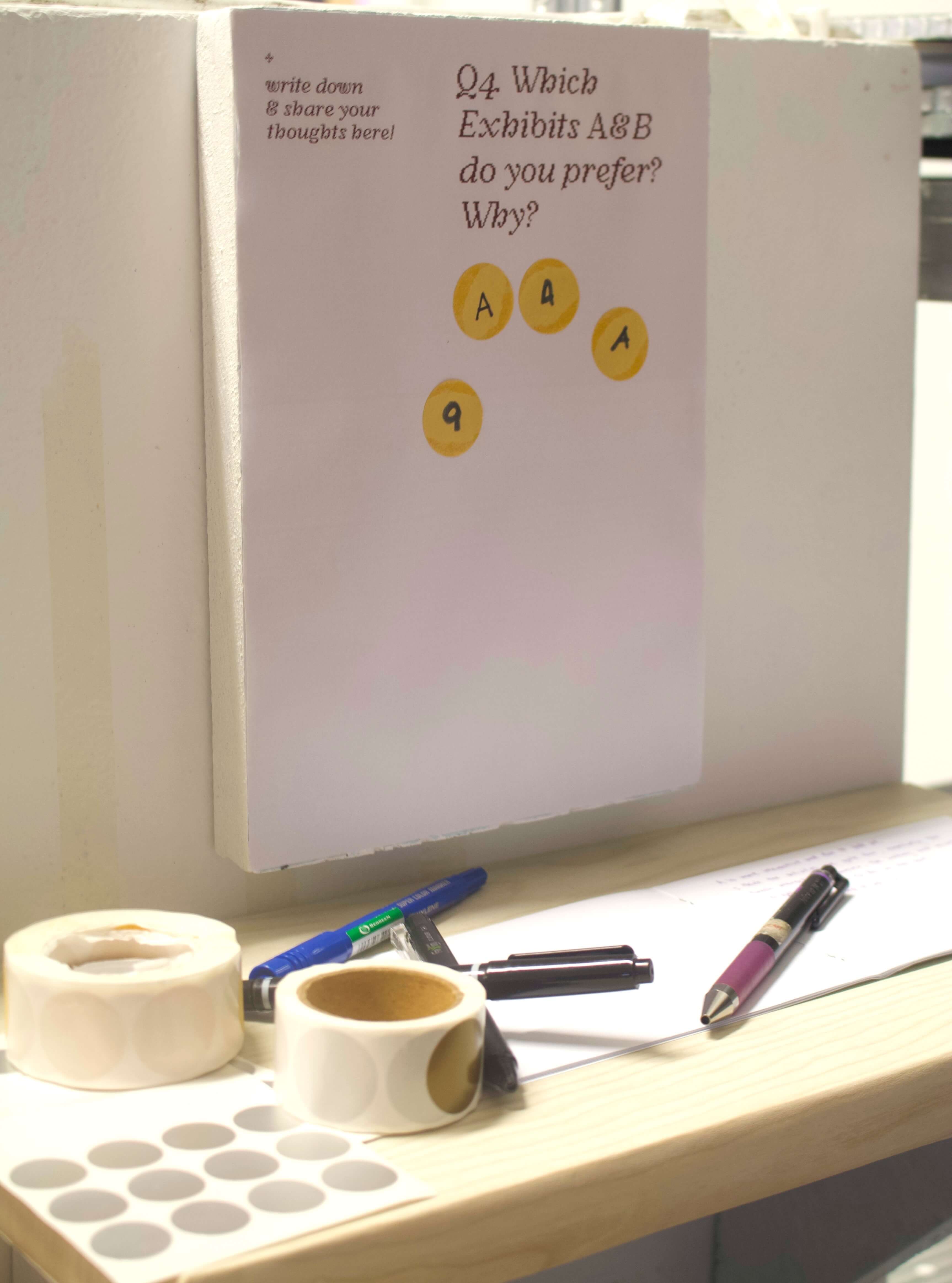
12. DIY Shelvings for 'Thoughts & Reflection' Corner
TABLE SETUP Video Documentation
EXHIBIT A - MNEMOSONIC BOX (Insights)
I have observed that many visitors are attracted to my table setup as they were curious about the Mnemosonic Box. After interacting with them I found out that it was because of the overall aesthetic and them being genuinely curious about how I made it work after knowing the objects are auditory tactile and can produce sounds. I even have some people commenting they thought it was an actual wooden box until they touched it themselves.
There were also a few people who really liked my Mnemosonic booklet, someone even asked me what was the font I used - it was Argent Pixel. Andreas also commented that the booklet was really well done and he liked the idea of having a booklet to collate all the memories featured in the sound box and it helped give purpose while guide them through the process of interacting with the box. The booklet also elevated the design aesthetic of the whole project and made it look more professional as a visual communication designer. He also mentioned the typeface I used was really nice and it was a good choice to use a pixelated font as it somehow fits the theme of the project. I was really happy to hear that.
There were some challenges that I faced with Exhibit A. One of them is the touch sensitivity, which affects whether the sound would play or not. Some objects like the teddy bear, swing, ice cream bell, car, were sensitive to touch and could easily produce the soundscapes which was intended. I always get big reactions or smiles from the participants when they hear the sound. However, some other objects like the cooking pot,computer,present, were not sensitive enough to trigger the sound. I had to be there to help them touch it properly (there is a trick for that; either touch a specific place or gently lift it up to touch the bottom where the wire is at) so that they could hear the sound. This was a minor challenge as I had to be there to guide them through the process of interacting with the box.
The second challenge was that occasionally, the sounds could not be heard either because the volume started from soft to loud which could confuse the pariticipants, thinking there is no sound but it's actually playing. Some of them would also keep pressing and tapping on the objects repeatedly when they should only be touching it once. Sometimes the sound would also not play at all because of the previous touch sensitivity problem which might lead to them losing interest in the box and the whole experience.
Lastly, not alot of people are willing to spend too much time drawing and filling out the postcards as they just want to try out the box and move on to the next exhibit. I had to be there to encourage them to fill out the postcards and explain the purpose of it, which was to help them recall their memories and thoughts after interacting with the box.
Moving forward, I should adjust the volume of the soundscape and just let it start loud, especially the coffin, dog, present, so that they could hear it better. I should also find ways to increase the touch sensitivity of the objects maybe by placing copper tape on the bottom or around the objects and repaint them, so that they can be more sensitive to touch and trigger the sound more easily. One thing I could do was to explain to the visitors that they could take the postcard home as a souvenir, which might make them more willing to fill it out. After they are done, I could take snapshots of it so that I can use it for my documentation and also to show them that their postcards are purposeful and they are contributing as the postcards are actually being used for data collection.
pressing specific areas to trigger sound (works) lightly tapping the object to trigger sound (doesn't work)
EXHIBIT B - MNEMOSONIC MAP (Insights)
Throughout the 3 days of open studios, I realised that many visitors and participants showed more interests and were way more engaged during Exhibit B - Mnemosonic Map. It was because of the stamping activity that I had prepared as a fun and interactive way for them to engage with the exhibit.
There were definitely challenges that I also faced with Exhibit B. One of the major ones was that some of the ambience sound was not loud enough for them to hear clearly. Only specific ones like the bird, fireworks and restaurant were pretty loud, despite the hustle and bustle environment in the class during Open Studios. However, as my sit was situated near the communal area for the students to continue working on our projects, many of them misused the place to gather around and talk loudly which unfortunately did play a part in affecting my exhibit experience for the participants. The sounds which were supposed to be relaxing and calming were drowned out by the loud chatter of the students.
The second minor challenge was that sometimes the exhibit requires me to be personally there to reupload the code to the arduino board. This was because the reed sensor was not working properly, so I had to be there to reset the code.
Sometimes, participants are also unsure where on the stamping card should they stamp on as the image on the lino stamp does not correspond to the one on the stamping card. Hence, I had to help them with the stamping activity to make sure that they were stamping it correctly, which can cause minor disuptions to the memory recall. They were not able to fully immerse themselves in the experience, as it unintentionally became a matching game.
Moving forward, I should adjust the volume of the ambience, especially the wind, pool and so on, so that they could hear it better. I should also reprint the stamp cards where the images are the same as the ones on the linostamps, also labelling each one of them so they know what sound they are listening to.
1 to 1 interaction with an immersed participant participant picking up a stamp after listening to an ambience
PRODUCTION PLAN
for Week 13 to 15
Time is ticking and I'm left with only 3 weeks to finalise my project. I have to make sure that I am able to complete all the deliverables and prepare for the final presentation. I am reflecting on the feedbacks that I received from the Open Studios and how I can improve on my project within the next 3 weeks.
Reflection: Areas of Improvement
One of the major feedbacks that I received was to improve on the sound quality of the ambience sounds. Currently, I have 3 solutions to that. I can either replace the current built-in amplifier in the DF player to another speaker where I'll need Andreas' help to solder and code. Another solution is to use a headphone jack and connect it to a speaker. The last solution is to further amplify the sound manually and replace the MP3 file with a higher quality file.
The next concern that was brought up by Andreas was that the Mnemosonic Map could have little to few visual guides so that the participants can have a better understanding of how to navigate through the map. I was thinking of adding dotted lines to indicate the path that they should take, and also adding a legend to indicate the different sounds that are available on the map. This could either be done on the map itself or on a seperate piece of physical map for reference.
In my opinion, doing on a seperate piece of paper would be better as the concept was originally to have the map as an invisible map where participants have to wander around to find the sounds, just like in an actual world where you have to walk around and explore the world, only then you will hear different soundscapes in different places. Participants can also choose whether they want to refer to the map or not, so that they can have a more immersive experience.
-
Summary: Improve on AB Experiential Prototypes
- ✧ Wk.13 - Sound Quality, Device & Visual Map
- ✧ Wk.14 - The above + Edit Explainer Video
- ✧ Wk.15 - Printed Booklets, Set-Up & Slides
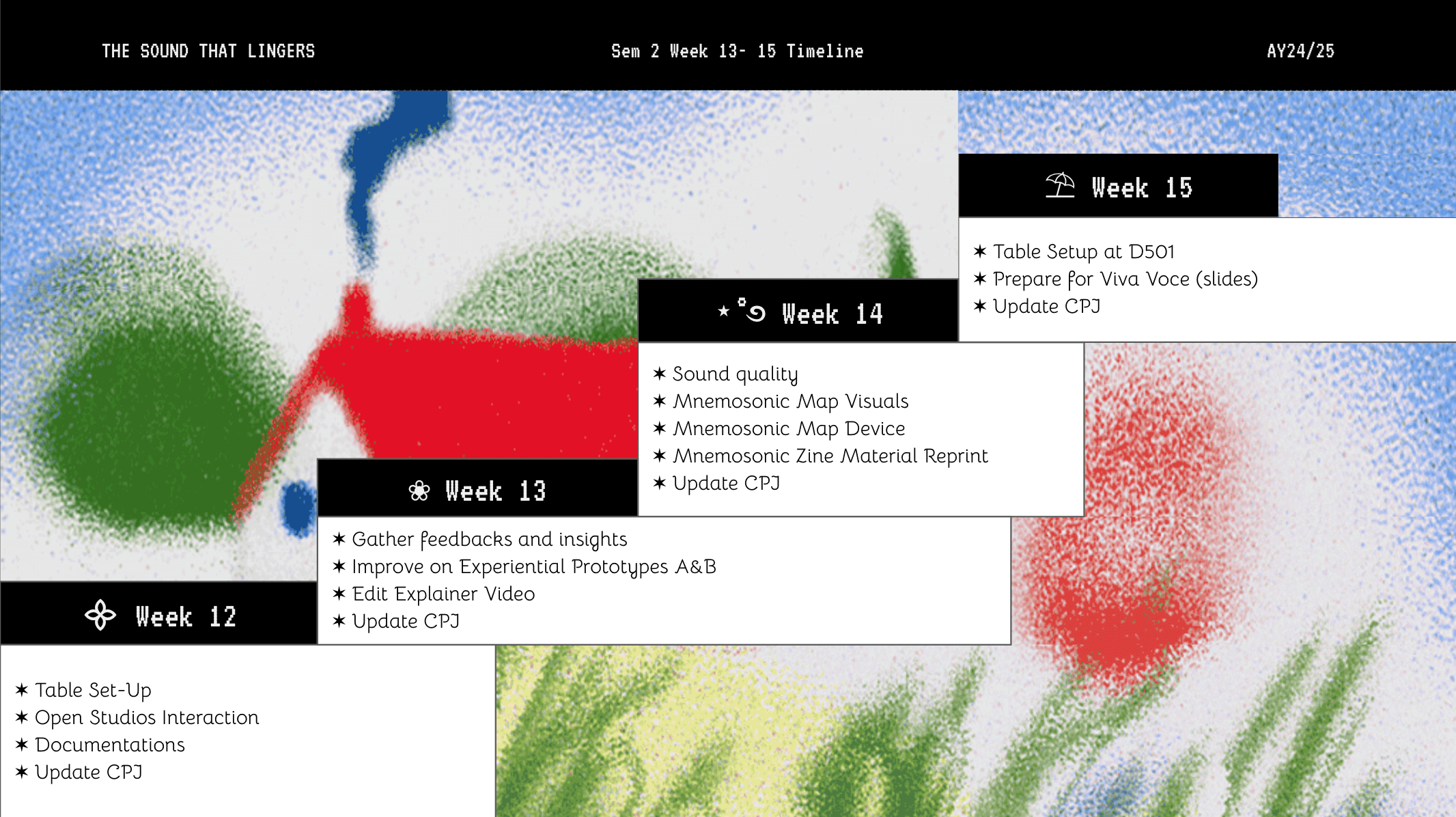
PERSONAL TAKEAWAYS & INSIGHTS
To be honest, I was really nervous about the Open Studios as I was not sure how the participants would react to my project, at the same time I was so excited to showcase my work to the public and am curious how they would react to it. As someone who is slightly more towards an introvert, I had to definitely step out of my comfort zone to put myself out there when explaining and selling my idea to the people who come to me. I was also worried that they would not be able to understand the concept and purpose. However, I was pleasantly surprised by the positive feedbacks that I received from them. Many of them who came to my table were really engaged and interested in the project, and they were able to understand the concept of sound as the main tool for memory trigger quite well. There were 3 groups who left a deep impression in me.
On day 1, there was a girl who displayed great interest in my work, she kept smiling and nodding as I explained my work to her. Even though she was only there for awhile, she told me she found my work interesting and really cool, her enthusiasm and praises really made my day. Having found out that she was a Year 2 junior, I also shared some tips with her.
The next day, there was a group of girls who spent a really long time interacting with my project from the start to the end. I was initially away from my table and as I returned, I saw two girls referencing my explainer video and self-guided themselves through Exhibit A. This showed that the explainer video did aid and enhance the overal experience which I was glad to witness. I decided to observe them abit more from afar before greeting them. After that I saw them moving on to Exhibit B, where they already started hovering the magnet above and were really immersed in the sounds and ambience, even bending down to listen better. They were so into it that they even forgot to stamp their cards! I was really happy to see that they were enjoying themselves and having fun with the stamping activity. After they completed the whole exhibit, they even exclaimed how much they enjoyed the experience and how they loved the idea of using sound as a tool for memory recall.
Day 3 was surprisingly the most hectic out of all 3 days where I suddenly found myself conversing with a huge group as shown in the picture on the right. The guy closest to me in the picture was really immersed in my work and kept on asking questions like: "How did you collect these sounds?", "How does this magnet trigger sound, how does it work?", "Were these your memories? How did you decide on only these sounds?", so on and so forth. I was surpised that I was actually having a blast answering these never-ending questions that kept coming at me as I knew the answers to all of them and I was so eager to share my thought-process to like-minded people who get why I'm doing this and people who are interested in my work. After completing all of the exhibits, he even left me words of encouragement, saying he really liked my work and even took photographs of my mnemosonic box and set-up. Therefore despite all of my initial concerns, I was really happy with the outcome of the Open Studios and I am grateful for the opportunity to showcase my work. Being in Lasalle for 3 years, I think this is the first time I actually felt like a real designer, showcasing my cretive work to the public and having them appreciate it, this satisfactory feeling is really indescribable.
COMMENTARIES by Visitors
throughout Open Studios
✧ Interesting concept using
sound as a tool to remember
"I am intrigued by your idea of using sound as a tool for memory recall. I think it is a really interesting concept and I love the idea of the 2 different exhibits. I think it is a really good way to explore the concept of memory and how sound can be used to trigger memories. I also love the idea of using the magnet to trigger the sound, it is really cool."
✧ The Mnemosonic Box is more impactful as it has both audio and visual elements
"I am not really an auditory person but a visual learner. I think the Mnemosonic box helps trigger memory better as I can also see the visuals while listening to the sounds. Although I am not really a sound person, I agree that it did help trigger memory that I haven't thought of in long while and sound is better than a still photograph just like a how a video has sounds. I can also see now that sound is important in our lives and it is interesting to see how sound can be used to make us recall things which is not something I would have thought of, its uncommon and unique."
-
✧ The Mnemosonic Map is more engaging, fun, relatable, intuitive and unexpected
"I actually prefer B because it helps me remember my own memory without having visuals that distract me. Even though I prefer A in terms of the aesthetics and collective memory concept, I think B is more relatable to my own life. I can relate to the sounds and it is more intuitive for me to remember my own memories. I also think that the stamping activity is really fun and engaging, it is unexpected and I didn't expect to have so much fun with it. I think it is a really good way to engage with the audience and make them feel more involved in the experience."
